

Albany
Cattle Sale Every Wednesday 9:30 AM(CT)
Jeffery Cyphers 270-459-1193



Cattle Sale Every Wednesday 9:30 AM(CT)
Jeffery Cyphers 270-459-1193
Cattle Sales Every Monday & Tuesday 9:00 AM
Cow Sale 4th Wednesday of Every Month 6:30 PM
Jeremy Shryock 859-967-6479
Cattle Sales Every Wednesday & Saturday 10:00 AM
1st Friday Every Month 7:00 PM
Ronnie Choate 270-465-4051 or 270-766-8240
Cattle Sales Every Wednesday 8:30 AM
1st Friday Every Month 6:30 PM
Jeff Copher 859-229-7587
Cattle Sales Every Tuesday 10:00 AM
Cattle Sales Every Saturday 11:00 AM
Corey Story 606-209-1543
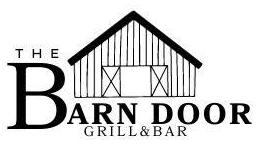
Cattle Sales Every Friday 9:00 AM
Hog, Goat & Sheep Sale 2nd & 4th Monday Every Month 1:00 PM
Jim Dause 859-314-7211
Cattle Sales Every Monday & Thursday 8:30 AM
Cow Sale 3rd Friday of Every Month 6:30 PM
Dylan Holt 502-680-4903
Internet at Blue Grass
Video Sales As Announced
Adam Menker 419-310-5344

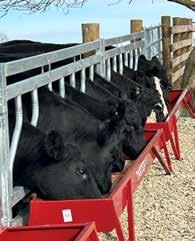


My dogs have gotten fat. They are not obese, but they have gotten a little portly. They are 6-year-old mutts that are predominately a beagle lab mix that evenly split the same size cup of food between them twice a day. At the end of the day, they have a rawhide to chew on. The calorie intake I have given them has not changed. These dogs are also highly active. If Cassie has them on the leash, they walk at least three miles daily. If we have them in the yard playing as they wish, their play resembles a rugby scrum. I was somewhat perplexed about why they have a little more jiggle when they trot. Then, I realized I was no longer the only one feeding them. They have also started to be fed by my 10-month-old son.
Shepherd eats what we eat. Every night, he has some sort of plate of meat and veggies and finishes it with some fruit. About half of what we feed him obviously ends up on the floor at this age. This is where our four-legged kitchen cleaners enter the story. Despite the small portion size for a 22-pound baby, even half of it appears to have made a difference in these active, 50-pound dogs. While we recognize the root of the problem and have adjusted their kibble diet accordingly, it is incredible what a marginal increase can do to a couple dogs that have followed a tight schedule their entire lives.
As we enter winter a little earlier in the mid-south than what we are typically accustomed to, we can think of applying this same principle to our cow herd nutrition. I feel like feed is a four-letter word to many producers. In fact, it can feel like there is a sense of pride in how little some people can get their cattle by on. While minimizing hay feeding days and maximizing grazing days is the sure-fire way to increase profit (and should be the goal of your forage program), we need to go ahead and feed when it comes time to feed. One of the most significant expenses in my winter feed bill is the cost of actually getting out into the field. The labor and equipment cost to truck feed down the road is significant. The additional 2 pounds per head per day of whatever grain you feed your cow herd may only cost $0.15- $0.25 per head per day. The extra 2 pounds of feed each day will go entirely to gain on that cow. (This assumes you are already meeting maintenance requirements. If you don’t understand this concept, consult a nutritionist). It can’t cost you more


than an additional $50 per head for the entire winter. I can guarantee you, much like in my dogs, those extra calories will be noticeable over the course of a few months. If cattle were cheap and grain was $300/ton, I may not be so adamant with my message. However, for that $50 in feed, you will see an extra half a body condition in that spring-calving cow, a stronger and healthier calf at birth, better quality colostrum from the cow, cows that cycle earlier, and your thinnest cows and/or latest calving cows are more likely breed back instead of coming up open. That is one of the best ROIs I can find in a record-high cattle market. That and an investment in a good bull.


COMMITTEE
OFFICERS:
President
JEFF PETTIT Sebree
President Elect
RANDY WARNER Sharpsburg
Vice President
ALLAN BRYANT Eminence
Treasurer
KEN ADAMS Upton
Past President
ANDY BISHOP Cox’s Creek
KCA Program Chairman
DANIEL HAYDEN Whitesville
KBC Chairman
RYAN MILLER Lebanon
KBN Chairman*
ALLAN BRYANT
Beef Solutions Chairman*
DANIEL HAYDEN *ex officio
REGION 1
Wayne Zoglmann, John Mark Brown, Ashley Holloway, Leland Steely, Gary Woodall, Coleman Ladd, Susan Zoglmann, Bill Plemmons, Kenton Howard, Sara Roberson
REGION 2
Phyllis Gentry, Joe Lowe, Allison Nissley, Rayetta Boone, Robbie Hatfield, Chris Imbruglio, Maggie Webb, Mike Jones, Corbin Cowles, Glenn Byrd, Isaac Thompson, Kenneth Green, Trent Jones, Brian Manion, Joe Mike Moore, Amy Cecil
REGION 3
Amanda Hall, Nathan Lawson, James Brown, Phillip Douglas, Larry Bryant, Lincoln Clifford, Abbey Biddle, Ben Tinsley, Kevin Perkins, Kyle Bush, Michelle Simon, Craig Retzlaff
REGION 4
Amy White, Brad Reynolds, Chad Anglin, Phillip Stamm, Danielle Harmon, Bruce Witt, Jodi Purvis, Mike Ravencraft, Ronnie Lowe, Danny Callahan, Jason Crowe, Rob Amburgey
REGION 5
Adam Chunglo, Brent Woodrum, Tommy Spalding, Dean Craft, Doris Hamilton, Rick Brewer, Brent Williams, Anne Bays, Terry Mattingly, Ryan Miller, Phillip Reese, Tommy Glasscock

Kelly
Todd
Bradon
Rachel
Amelia
Danny
Jake
Dan
Debby
Katie
Kelly

Jeff Pettit KCA President
And…. It’s over! Wow, it seems like yesterday I was writing my first article for Cow Country! I am blessed and honored to have served as your president for the past year. There are many ways that we can measure the success of our organization, and I know that we have experienced some wins this year that will continue to benefit Kentucky beef producers for many years to come. I am thankful to have served during this time. These wins were truly KCA team wins. While certain individuals may have been the leader on any given project, they had the support of everyone on the KCA team, and that is what it takes to achieve greatness! I promise you that there is no other cattlemen’s association in the U.S. that has the team KCA has working for its members and producers! So next time you have an opportunity to speak with one of the KCA team members, please tell them how much you appreciate all that they do!
Over the past year, I have been to many places and been a part of many conversations centered around beef production, food safety, traceability, cattle handling, regulations, cattle markets and so much more. Many times, when we are on the farm, we get so busy doing the daily chores we forget what all is at play in our industry. Whether you realize it or not, it will influence what you do on your farm. I challenge you to please get involved. Agriculture needs you; hungry nations need you. The world we live in is growing faster every day, and that means more pounds of food needs to be produced in fields and on farms rather than in labs and petri dishes! We need you involved in production as well as advocacy. No one is better than the American farmer at producing high quality protein and grains to feed the growing world we live in!
My visits to South Korea and Tokyo, Japan this past year with the U.S. Meat Export Federation really drove home the point of how precious yet how fragile American agriculture really is. Those countries both must import the majority of the food required to feed their population. I hope and pray we never get to that point here in the U.S. Your first thought is, “oh, that will never happen in the U.S.” I caution you to take notice of what is going on today. We have the smallest cow herd in around 60 years. Agriculture acreage is being pulled out of production on an hourly basis every day and more producers are retiring from agriculture than we have new ones coming in. Is that sustainable?
I challenge you to get involved in whatever way you can. Be the one to make a difference!
God created each and everyone of us with a unique ability, and all of those abilities have to do with serving others in some way. I ask you, are you using your talents to serve as His vessel?
There are so many people that I need to say, “thank you” to for their help, encouragement and support this past year. I am not going to name names as I will surely forget someone in the process, but please know I appreciate every one one of you!
I’m not saying goodbye, just see you later!


feedstuff value and improving cattle performance.





Jonathan Shell Agriculture Commissioner
It’s hard to believe a year has passed since I was sworn in as Kentucky’s commissioner of agriculture. From day one, my team and I at the Kentucky Department of Agriculture set ambitious goals to strengthen the agricultural community and position our state as a leader in innovation, sustainability and economic growth. As 2024 kicked off, we wasted no time, and hit the ground running to tackle the challenges and opportunities ahead. Over the last 12 months, we’ve made significant strides that will benefit the future of agriculture in Kentucky for generations to come.
Allow me to revisit a few that I’m particularly proud of:
Agriculture is economic development
Agriculture is economic development is a simple but powerful idea: create more market value for farmers while strengthening Kentucky's agricultural infrastructure. This vision is rooted in a passion for advancing agriculture and ensuring the long-term prosperity of farming families across the state.
This concept resonated with key decision-makers, catching the attention of the Kentucky General Assembly. Recognizing the potential to boost the state’s economy and enhance opportunities for farmers, legislators committed $5 million toward agricultural economic development. This funding is a critical step in incentivizing and locating agricultural projects throughout Kentucky, reinforcing the supply chain and supporting families from Pikeville to Paducah.
With this momentum, we embarked on a statewide initiative to directly engage stakeholders. KDA hosted regional "Agriculture is Economic Development" meetings in Morehead, Owensboro, Murray and London. These gatherings provided a platform to align regional economic priorities and spark conversations about advancing agriculture. By the final
meeting in London, the enthusiasm was palpable with a sold-out crowd eager to explore the possibilities that lie ahead.
This initiative also inspired innovation in agricultural education. In March, Murray State University and KDA announced a groundbreaking partnership and launched an ag-focused economic development master’s degree program. This forward-thinking initiative equips future farmers and agricultural leaders with the tools and expertise needed to sustain and grow Kentucky's agricultural economy for generations.
From an initial idea to a statewide movement, the journey demonstrates the transformative power of collaboration, vision and investment in agriculture as a cornerstone of economic development in the commonwealth.
Farmer Care Initiative launched
In November, KDA joined officials from the Appalachian Regional Healthcare to launch the Farmer Care Initiative aimed at improving healthcare access, outcomes and overall wellness for rural farmers in Central and Eastern Kentucky. This collaboration was the first healthcare partnership with KDA’s program, Raising Hope. It underscores a mutual commitment by state and regional healthcare leadership to promote high-quality healthcare and safety resources for Kentucky’s agricultural community by prioritizing accessibility and education.
During the 2024 legislative session, KDA was allocated $1 million each in fiscal years 2025 and 2026 for Raising Hope, an initiative focused on rural mental health, suicide prevention and farm safety in Kentucky. The department has quickly utilized these funds to expand health screening offerings while enhancing targeted marketing and promotional efforts to maximize the program’s impact.
In May, KDA partnered with the Kentucky Hospital Association to launch the “Food is Medicine” campaign, emphasizing the transformative role of nutritious, locally sourced food in promoting healthier living. This initiative highlights how accessible, healthy food can improve patient outcomes and overall community health.
As part of the campaign, I participated in five “Food is Medicine” roundtable discussions at hospitals in Hazard, Madisonville, Owensboro, Russell Springs and Pikeville. These conversations brought together local leaders, healthcare professionals and agricultural stakeholders to explore how hospitals can prescribe food as medicine, fostering better access to locally grown, nutrient-rich foods for patients.
Building on this mission, we’re proud to announce an exciting new partnership between KDA, Appalachian Regional Healthcare and the Kentucky Cattlemen’s Association. Together, we’ve developed a specialty burger made with locally sourced beef, now available in all ARH locations. This partnership not only promotes healthier, local options but also supports Kentucky farmers by integrating their products directly into healthcare and food service systems. These efforts demonstrate the vital connections between agriculture, health and community well-being, showing how partnerships can create lasting impacts for both people and farmers across the commonwealth.
I traveled throughout Kentucky last summer to personally present awards to food-based agribusinesses that prioritized buying local food products for their establishments. Nine businesses received Lifetime Awards for their commitment to KDA’s Buy Local program.
Buy Local is an incentive program rewarding restaurants and other food service participants for enhancing their menus with locally sourced Kentucky Proud ingredients. Through
early December 2024, KDA awarded nearly $170,000 in reimbursements for marketing expenses for Kentucky Proud members, and more than $795,000 worth of items with direct farm impact had been purchased through the Buy Local Program. This program strengthens local economies and aligns with our marketing efforts to promote Kentucky Proud as demonstrated by the 31 Farm to Fork meals across the state last year, which generated more than $180,000 for charitable organizations.
Gas pump inspection stickers
If you’ve pumped gas during the past nine months, you may have noticed a special message on KDA’s 2024 inspection stickers. It reminds drivers not to leave children or pets in an unattended hot car. In 2023, 29 children across the nation died due to vehicular heatstroke. Pediatric vehicular heatstroke is one of the leading causes of non-crash, vehiclerelated deaths for passengers ages 14 and younger. I’m hoping more awareness prevents the unnecessary deaths of children or pets. Combining that message with the stickers on approximately 60,000 gas pumps that KDA inspectors check annually just seemed natural.
As we step into 2025, I am proud of the strides we’ve made and optimistic about the road ahead for Kentucky agriculture. The accomplishments of the past year reflect the dedication of the Kentucky Department of Agriculture and the partnerships we’ve fostered across the state. From economic development initiatives and healthcare improvements to innovative marketing efforts and safety campaigns, we are working to ensure a stronger, healthier and more sustainable future for our agricultural community. I look forward to building on this momentum, continuing to serve Kentucky’s farmers, and championing the vital role agriculture plays in our commonwealth. Together, we will keep cultivating success.

Herefords are known as the efficiency experts for a reason. Herefords boost pregnancy rates by 7% and add $30 per head in feedyard profitability in a crossbreeding system. And Hereford genetics bring unrivaled hybrid vigor, longevity and disposition.

Dave Maples Executive Vice President
I know this is the January Issue of Cow Country News, but I am writing this article just a few weeks after Thanksgiving so bear with me. This story actually occurs on the afternoon on Friday after Thanksgiving. First, let me say a few words about Thanksgiving at my house. My wife is the best cook that I could have ever asked for. I mean she is good. She enjoys cooking, and she does a good job. People like to come to our house and eat her cooking. Living hundreds of miles away from family, we have always welcomed people to our Thanksgiving dinner who don’t have local family or anywhere else to go. As such, it is always a different array of people at our home that day. This year, our guests included my son and daughter’s friends, who were mostly from other states and countries. Friday afternoon, everyone was gone, and the house was quiet. I had just gotten a nice big slice of chocolate pie with a 4-inch-tall meringue and positioned myself in my big recliner. Two bites in my phone rang, and it was my neighbor Charles Miller. Mr. Miller had gotten a call from his neighbor Vicky, and she said her husband was on a trucking job in California and that she had a cow in labor and asked if he would come help her. Please understand that Mr. Miller is the person in our community that people go to for advice or help on anything related to a cow. I am sure you have that person in your community. Mr. Miller’s request to me was would I go with him to help Vicky and her son with the cow? Doing what good neighbors do, I went to help.
I have helped pull lots of calves in my lifetime. During my early childhood days, it was always so exciting when we had to pull a calf. Then, we used hay strings with a stick wrapped a round the end to pull calves with everyone that dad could find to help. Most of the time, we could get the calves out, but there were times when we had to call the vet. I was hoping that this would be just an easy straight forward quick event. Wrong… When I approached the cow, I could see a little tail. I just turned to Mr. Miller and said, “We can’t do this. You are going to have to call the vet”. Mr. Miller has a very good relationship with his veterinarian Dr. Chris Jolly. When he called Dr. Jolly there was no answer but he quickly returned the phone call. Dr. Jolly was on his way to get a set of tires and was not in his vet truck, but he came to help. If everything had gone right, it would have been quick, but the cow went down. Also, remember it is now a late Friday afternoon. Dr. Jolly tried, but he had to leave and go get his tires and give the cow time to get up. When he got back, it was almost dark. I had my hand on the cow’s side so she wouldn’t fall over again. I have seen lots of dystocia and several breach deliveries, but it was like magic when Dr. Jolly got that second leg turned. And I just said, “How did you do that? How did you do
that?” He was very tired at this point, and he just made a strong −well really a little more than strong− comment to me with nine people watching him do his work that, “he had a good education and was trained.”
My family’s veterinarians have been trusted, well-respected professionals throughout my entire life/career. And at the point when Dr. Jolly said what he said about “his training,” it just remined me that I have to listen to him about how we train future veterinarians. He knows what it takes to get through vet school and pass all the tests to be a licensed practicing veterinarian.
Different veterinary education models are emerging and include online, distributed models, 2 plus 2 models and others, but the practice of veterinarian medicine is a contact sport that requires both intellectual abilities as well as hands-on training and repetition. Vet school is not easy, and it shouldn’t be. It is not for everyone, and we as producers should expect the best for our animals.
But we as producers are going to have to support our veterinarians if you want then to come out on a holiday weekend. If you have food animals, you have to have a Veterinary Client Patient Relationship (VCPR). This relationship requires you to have the veterinarian on your farm at lease once every year. It is just simply good business to have an established relationship with your veterinarian.


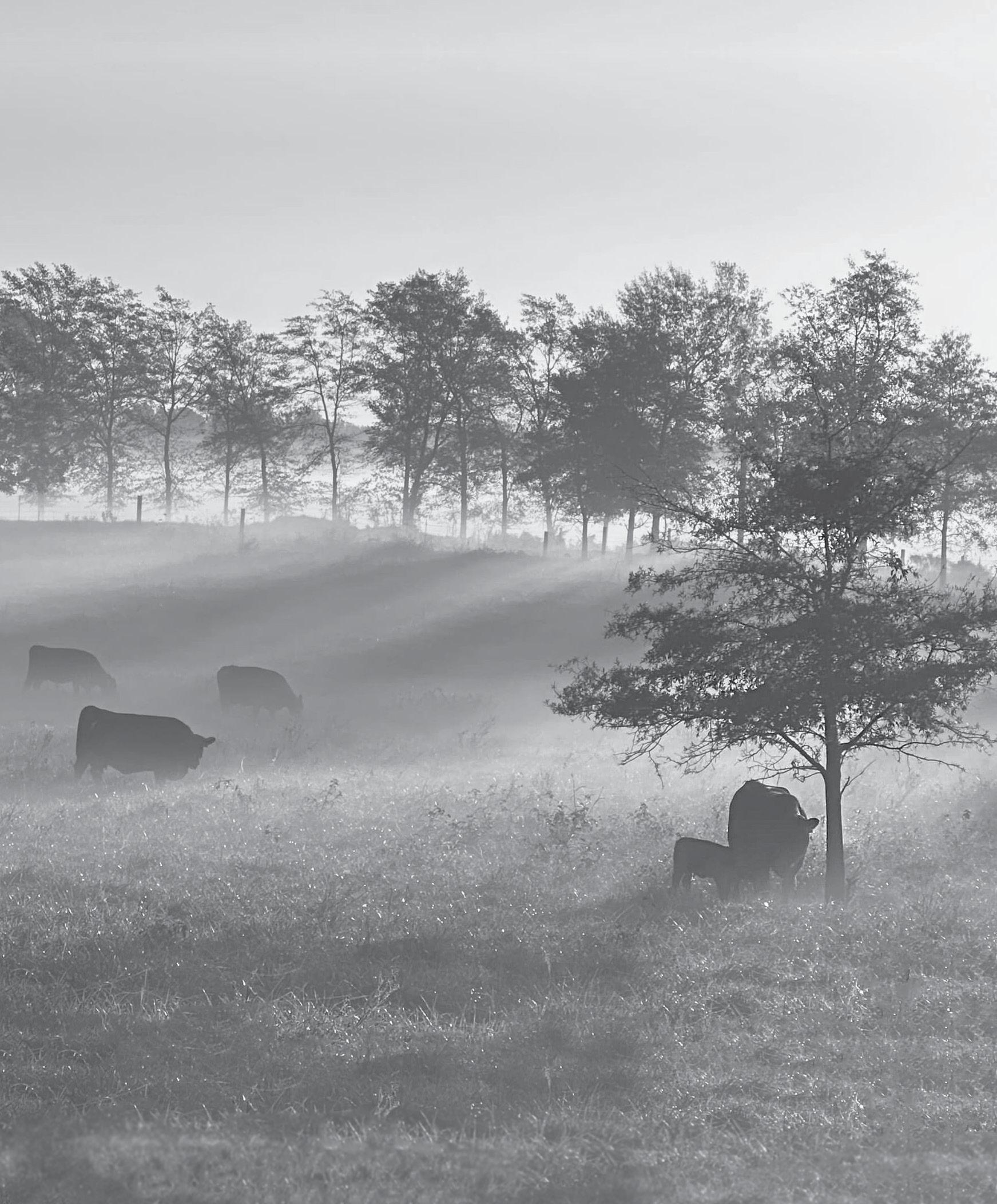


submitted by Carol Spiegl
The Barren County Cattlemen’s Association met on Nov. 14. The meeting and meal were sponsored by Kentucky Farm Bureau and Tarry’s Fencing. Pictured from left are Matt London with Kentucky Farm Bureau, Jim Guffey with the Barren County Cattlemen’s, and Jeff and Abby Tarry with Tarry’s Fencing.
submitted by Tyler Ray
On Nov. 12, the Boyle County Cattlemen’s Association held their 2nd annual chili dinner. The chili dinner was open to the community. This event not only served as an opportunity for fellowship, but to make a difference during the holiday season.
Donations were collected to sponsor a local Boyle County family in need, in partnership with a local family youth resource center. Thanks to the wonderful generosity of attendees, $830 was raised to brighten the holiday season for a family.
A silent auction was held to support the Jere C. Caldwell Memorial Scholarship, which supports incoming college freshmen pursuing a degree in agriculture. This scholarship honors the legacy of Jere C. Caldwell by fostering the next generation of agricultural leaders.
Thank you to all who made this event a great success!
submitted by Rayetta Boone
Grayson County Cattlemen recently cooked hamburgers for Wilson and Muir Bank’s Customer Appreciation event in Leitchfield. Grayson County FFA members and their advisor assisted the cattlemen with serving the food.








submitted by Kim
Sparks
The Lewis County Cattlemen’s Association recently met and toured the new Lewis County Career and Technical School. Lewis County High School ag teacher, Tyler Clark, and FFA members were on hand to give tours and help out during the association’s meeting. Lewis County Cattlemen’s President Phillip Stamm, extension agent Kennedy Perkins and association members were especially pleased to see the school’s ag lab and hear how well the program is doing.
submitted by John Walpole
The Logan County Cattlemen hosted their quarterly meeting. Guest speakers were Warren Beeler, deputy agriculture commissioner, and Dave Maples, executive vice president of the Kentucky Cattlemen’s Association.
During the meeting, Wayne Johnson was named the association’s member of the year for the countless hours he has spent volunteering with the association, which includes serving as treasurer for the past 8 years. Johnson owns Mud River Angus, a purebred breeding operation.
During December, the cattlemen catered the Christmas dinners of the Logan Telephone Co-op and Southern States.




Five $1,500 Scholarships are available through the Kentucky Cattlemen's Association and are funded by the Kentucky Cattlemen's Foundation.
Requirements:
• Must be a graduate from a Kentucky public, private, charter, or homeschool in the year of the application
• Must be enrolled and attending an institute of higher education following graduation
• Must be planning to major in agriculture or an agriculturally-related subject
• Applicant or their parent/guardian must be an active member of the Kentucky Cattlemen's Association Applications for the 2025 KCF Youth Scholarships should be submitted by March 31, 2025



Monday, February 24, 2025 1291 North Stroudsville Road, Adams, TN
Visit our website for an in-depth look at
Joe Elliott • (615) 969-2205 resjoe@bellsouth.net
William B. Elliott • (615) 505-9234 reswbe@outlook.com
Lake Elliott • (615) 483-2444 resdubman@gmail.com







Katie Pratt Kentucky Cattlemen's Association
EZEL, KY− Morgan County producer Ronald Cole cares about his cattle and improving his operation. He also wants his neighbors to succeed. Over the years, Cole’s knowledge of agriculture and his willingness to share it with others has made him a leader in the Morgan County agriculture community.
“When people want to know what works well and what doesn’t, they talk to Ronald,” said Sarah Fannin, Morgan County extension agent for agriculture and natural resources. “He is willing to talk to new farmers and gives them practical advice.”
Ron Shrout, Kentucky Beef Network field associate met Cole when he was participating in the East Kentucky Heifer Development Program in the early 2000s.
“He’s a hard worker and a good leader in the community who is always on top of everything,” Shrout said. “He has always been one of the people that will help other producers understand and meet the requirements to participate in things like CPH sales.”
Love for cattle
Cole has a cow-calf operation with around 125 mamas. He owns 500 acres and leases another 450-500 acres. His herd is split between falland spring-calving animals.
Cole enjoys talking about his cattle. The excitement in his voice builds as he shares stories of some of his favorite cattle, including a cow named "Lily" that was bottle fed as a calf and has become a cherished member of his herd.
Farming has always been a family activity for Cole. He began farming with his dad, Ronnie, and his grandfather. His dad continues to play an integral part in the operation. Cole’s farm has been in his family since at least the 1940s starting with his grandparents. He lives in their
house, which is next to his parents’ home. Even though Cole’s daughters have grown up and moved off the farm, they continue to own a few of the cattle that Cole raises. His cousin, Greg Havens, also began helping on the farm in 2021.
For 19 years, Ronald Cole produced cattle and raised tobacco on a parttime basis with his dad while he worked an off-farm, third-shift job with the Kentucky Department of Juvenile Justice at the Woods Bend Youth Development Center.
“My job with the Kentucky Department of Juvenile Justice actually worked out really well for me at the time because I could farm with my dad during the day and I was always able to make it to my daughters’ softball and basketball games before going to work,” he said. After retiring from the Department of Juvenile Justice in 2020, Cole returned to the farm full-time.
Community minded
Even with family and farming obligations, Cole has made time to serve on local agriculture boards over the years. He served two terms on the county’s agriculture development council, which is in charge of dispersing County Agriculture Investment Program funds.
“He really helped shape how CAIP funds are used in our county and helped make sure the funds were more equally distributed amongst county farmers,” Fannin said.
He also currently serves on the county’s soil and water conservation district board.
Always improving
Like many Kentucky producers, tobacco once played a large part in Cole’s operation even though he always had cattle. As the tobacco markets dwindled 15 years ago, cattle became the farm’s main focus. Cole grew his last tobacco crop in 2010, and his dad raised his last in 2006.
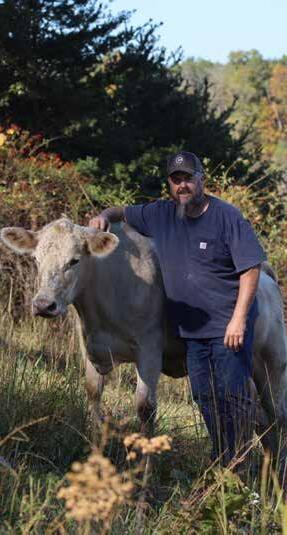


Cole has made many positive strides to his cattle operation over the years. He has focused on heifer retention and development. He tends to keep between 10-12 heifers each year, but will keep more if conditions are favorable for it. In 2024, he retained 26.
“Years ago, my parents would trade in cattle a little, but now the only thing that I buy off the off the farm is bulls,” he said. “I keep heifers to develop out of my better cows that have good calves, excellent milk production and breed early.”
He works with his vet to pregnancy check and get pelvic measurements on his heifers. He currently has nine bulls for his herd. For the past 20 years, he has used Angus bulls to produce cattle that are desired by the markets.
When his first-calf heifers are about a month away from calving, he brings them to a barn not far from his house to keep a close watch on them, provide them with a dry place to calve and troubleshoot any calving issues.
Cole is always looking for ways to improve his operation. He attended the Master Cattleman Program twice.
“He was able to take the knowledge he gained through the program and
couple it with his current knowledge to improve his operation,” Fannin said.
“He’s always willing to attend programs and ask questions,” Shrout said.
Pasture improvements
Cole spends a lot of time maintaining and improving his pastures. In an area with an abundance of forest, he works diligently to keep trees from encroaching on his pastures by mowing, fertilizing and grazing animals.
Steep hillsides often require the use of tall fescue to control soil erosion but Cole has worked clover, silage and haylage into his operation to improve the quality of feed his animals receive.
“He was an early adopter in our area for wrapping haylage in the spring,” Fannin said. “He also uses university recommendations on hybrid corn and forage genetics to diversify his forage base and improve his operation. He gets some of the highest hay quality values in our area.”
Each year, he will produce around 900 to 1,000 hay rolls for winter feeding. He makes haylage out of his clover and ryegrass fields. He also grows corn that he uses for either silage or grain.
He unrolls his hay rolls on the hillsides during winter feeding. This helps him get a more even distribution of nutrients from cattle deposits on the soil. It also helps him with controlling weeds, such as the troublesome broomsedge.
He also has two additional barns that he uses for winter feeding and also has other designated areas in his fields for winter feeding.
Cole primarily sells cattle through Blue Grass Stockyards in Lexington and his cull cattle to Beef Solutions. With these locations being 70 and 100 miles from Morgan County and some producers having limited transportation resources, Cole will help other producers transport their animals to market.
“He is very committed to agriculture and his operation and willing to help others,” Fannin said. “He has really expanded his leadership role in the community.”


BOZEMAN, MT — The American Simmental Association (ASA) recently honored Dr. Henry Allen, Versailles, Kentucky, with the World SimmentalFleckvieh Federation (WSFF) Golden Book Award, the association’s highest honor. Selected by the ASA board of trustees, recipients of this award are lifelong promoters of the Simmental breed. Allen was recognized during ASA’s Fall Focus event on Saturday, Aug. 24, in Amarillo, Texas.
Dr. Henry Allen first learned about the Simmental breed while working for Dr. Don Applegate, who was the president of the ASA board of trustees in 1979. Allen was drawn to the growth and performance of Simmental cattle, he purchased three heifers in 1974, and claimed membership number 004561. Allen owned several sires that were important to the breed early in its history, including "Achilles Superstar" and "Changing Times." He established Wayward Hill Farm, a seedstock operation that has now been in the SimGenetics business for five decades.
A veterinarian by trade, Allen has been practicing for over 50 years, specializing in cattle. At 76 years old, he hasn’t slowed down and currently does the veterinary work at two stockyards. Allen’s sons, Paul and Chris, came up in the American Junior Simmental Association (AJSA), both serving as president of the AJSA board of trustees. They each had many successes in the show ring, including exhibiting champion females at several AJSA National Classics.












Katie Pratt Kentucky Cattlemen's Association
BARBOURVILLE, KY- Laurel County beef producer Glenn Williams has been raising cattle since 1987. He runs S&J Cattle, a cow-calf and backgrounding operation that averages around 250 mama cows and 400 stockers each year. He has consistently sold his cull cattle into Beef Solutions, which produces and markets Kentucky Cattlemen’s Ground Beef since its inception in 2018.
Williams is just one of the many Eastern Kentucky cattle producers and Beef Solutions consignors welcoming a new partnership that will see Kentucky Cattlemen’s Ground Beef featured in a signature burger on the menu at 14 Appalachian Regional Healthcare (ARH) hospital cafeterias in Eastern Kentucky and West Virginia beginning in 2025. A notfor-profit, multi-hospital healthcare system, ARH is the largest provider of care in southeastern Kentucky with a workforce of around 6,500 at its multi-state locations.
“I started selling into Beef Solutions because I was looking for a better market for my cows, and it’s been great for me because of the number of cattle that I run,” Williams said. “I’m all for getting our nutritious meat into
other local avenues that grow support for local foods and help our own people improve their health.”
The ARH signature burger is called the Big Sky Barbeque Burger. It is a burger topped with hickory barbeque sauce and grilled onions.
The burger was made possible due to partnerships between the Kentucky Cattlemen’s Association, Beef Solutions, Appalachian Regional Healthcare, Sodexo and the Kentucky Department of Agriculture. As part of their mission, KCA and Beef Solutions staff work diligently to identify and develop new marketing opportunities for Kentucky cattle producers.
“We are very excited to enter into a partnership with Sodexo and ARH, which will continue to create more opportunities for Kentucky beef farmers to feed families across the region,” said Kenny Allen, Beef Solutions operations manager. “There have been numerous hurdles to cross getting to this point, but Beef Solutions will continue to work on behalf of the farmer to cultivate these opportunities. Many dedicated people from all of the groups involved have worked extremely hard to make this ARH signature burger happen.”
The announcement of the ARH signature burger featuring Kentucky Cattlemen’s Ground Beef was part of a larger announcement of the Farmer Care Initiative, which is a partnership between KDA and ARH. The initiative not only makes local foods more accessible for hospitals but will use ARH medical expertise to increase healthcare access and improve health outcomes for farmers and rural communities throughout Central and Eastern Kentucky.
“We are excited to be partnering with our local farming community to provide a signature locally produced burger that will be available to our employees, patients and their families,” said Hollie Harris, ARH President and CEO. “At ARH, we truly believe that the more local, fresh produce and protein that we can make available to our employees and patients, the healthier they are going to be.”
The Farmer Care Initiative was developed from the KDA’s and Kentucky Hospital Association’s Food as Medicine campaign, which aims to use nutritious locally produced foods to improve health outcomes in the state. ARH is the first healthcare system to collaborate with the KDA’s


Raising Hope to increase healthcare access and education in rural Kentucky.
“We are proud to partner with ARH to bring locally produced foods, like Kentucky Cattlemen’s Ground Beef, into the hospital system. This collaboration highlights the importance of supporting our local farmers while improving access to nutritious, high-quality meals for patients, employees and families,” said Agriculture Commissioner Jonathan Shell.
Lean beef is a nutritious option for consumers as it provides an excellent source of protein and includes 10 essential vitamins and minerals.
Beef Solutions is currently pursuing other opportunities that could see more Kentucky Cattlemen’s Ground Beef being used to improve the health of Kentuckians.
Producers who want more information about selling cattle into Beef Solutions can email beefsolutionsinfo@kycattle.org.
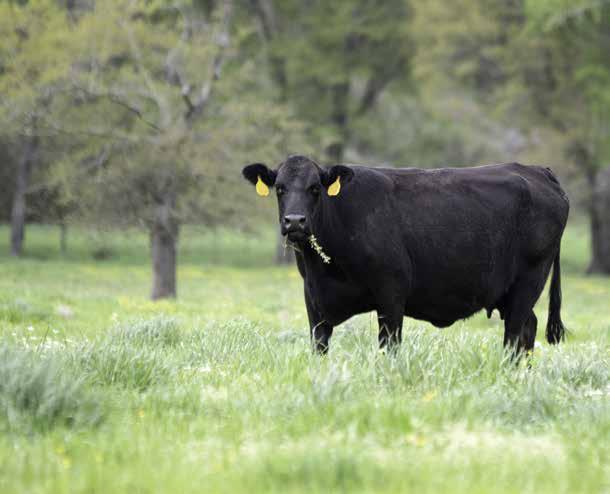

Wednesday
KCA Convention Welcome Reception
Thursday
Beef
Welcome Lunch in the Trade Show
Opening General Session
Women's Session 1
KCA Roundup Reception
Friday
KJCA Activities
Regional Meetings
Closing Business Meeting
Rural Veterinarian Panel
Women's Session 2
Forages at KCA
Evening Banquet
WEDNESDAY, JANUARY 15
10:00-5:00 Trade Show Move-in
2:00-4:00 KCA Foundation Meeting Riverwalk- Hampton Inn*
4:00 KCA Executive Committee Meeting Riverwalk- Hampton Inn*
6:00 KCA Leadership Dinner (Invitation Only)
6:00 KCA Beef Efficiency Conference Guests Dinner (Invitation Only)
7:30 KCA Convention Welcome Reception
THURSDAY, JANUARY 16
7:00-6:00 Registration Hours
7:00-10:00 Trade Show Move-In
Bank Ballroom- Bluegrass Hall of Fame*
9:00-11:30 Beef Efficiency Conference – Maximizing Efficiency: Balancing Nutrition, Genetics, and Forage for Success Fescue Toxicosis: Understanding Cattle Tolerance & Functional Forage Solutions - Dr. Brittany Davis, USDA-ARS Forage Research Center What is Optimum for Your Operation? - Dr. Aaron Berger, University of Nebraska-Lincoln Finding Forage Efficient Cows - Dr. David Lalman, Oklahoma State University
Trade Show Opens
1:30-3:30 Opening General Business Session Welcome 2024 Kentucky Cattlemen’s Association Convention – Jeff Pettit 2024 KCA President University of Kentucky Update – Dr. Laura Stephenson Dean of Martin-Gatton College of Agriculture, Food and Environment Kentucky Department of Agriculture Update – Jonathan Shell Kentucky Department of Agriculture Foot and Mouth Disease Preparedness and Response – Dr. Franklyn Garry Colorado State University
4:00-5:00 Women's Session 1: Mental Health + Ag : Breaking the Stigma to Continue A Legacy – Calli Thorne
6:00 Trade Show Closes
7:30-10:00 KCA Roundup Reception Best Burgers of Owensboro Tasting Event – J’s Good Grub & Kim’s Diner, Kentucky Cattlemen’s Ground Beef
JANUARY 17
6:30-5:00 Registration Hours
7:00-9:00 County President Breakfast (Invitation Only)
9:30-10:15 KJCA - Ice Breakers with KJCA Board
KCA - Concessions
12:30-2:00 Closing Business Session 2024 Financial Review - Ken Adams, KCA Treasurer NCBA Legislative Update- Kent Bacus, National Cattlemen’s Beef Association A Year in Review and 2025 Outlook - Dave Maples, KCA Executive Vice President
1:00-2:00 KJCA - Beef Marketing Challenge
2:00-3:00
2:30-3:30 Women's Session 2: Creating a Terrarium Annette Meyer Heisdorffer, Ph.D, Daviess County (Session Two Ticket Required)
2:30-4:30 Forages at KCA - Matching Genetics to Forage Resources
Welcome & Introductions – Chris Teutsch University of Kentucky Optimizing production with a forage focused system – Dan Glenn Deep Grass Graziers Genetics for Tall Fescue Based Systems – Dalton Bennett Knoll Crest Farm University of Kentucky Forage Extension Update – Ray Smith University of Kentucky
3:00-3:45 KJCA - Officer Meeting (Current KJCA Board Members Only)
3:45-4:45 KJCA - Board of Director Elections
5:00-6:00 KCA Leadership Alumni & Past President’s Reception (Invitation Only)
6:00 Evening Banquet (Ticket Required) KCA & KBC Awards 2025 KCA Hall of Fame Inductions Foundation Auction
Katie Pratt Kentucky Cattlemen's Association

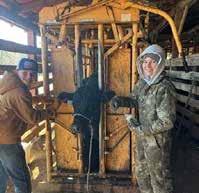
RUSSELLVILLE, KY – During the first weekend of December, dozens of young people in Logan County brought in steers to the extension office for the first weigh-in, hoping for an entry into the Logan County Cattlemen’s Association’s Steer Show, Sale and Carcass Contest.
The event, now in its 35th year, started as a partnership between the cattlemen’s association and 4-H as a way to provide another opportunity for local youth to gain education about livestock production.
In the program, youth raise steers for the show, and ultimately, for harvesting. In the process, the exhibitors, who must be Logan County youth between the ages of 9 and 21, must receive six hours of education in livestock production. These classes are given by local veterinarian Dr. Ellie Gripshover, who volunteers her time to the program.
Many of the steers are grown on participants’ farms, but a farming background is not necessary to compete. Some exhibitors purchase their steers from local producers or partner with neighboring farmers to house their animals. In December 2024, 36 youth exhibitors brought in 55 steers for their first weigh-in. This number included seven youth who were first-time participants.
The steers are weighed in December; they are reweighed in April to make sure they are on track to participate

in the contest. Steers must weigh at least 1,000 pounds to enter the show. They are weighed again at the show.
The steer show is held the Tuesday after Memorial Day. It is followed by a dinner and sale that evening. The steers are then slaughtered the next day, and their carcasses are judged for quality.
“It really is a full circle program for our youth,” said Leann Martin, the county’s agriculture and natural resources extension agent. “Not only do youth develop a deeper understanding for the hard work that goes into showing an animal but they also learn how to raise good quality beef cattle and create a good quality meat source.”
Youth can receive several financial awards through the program. They receive payment for the sale of their steer; they also receive awards for the largest daily gain average and carcass quality. These are added together to make the Steer of Merit, which is the highest quality steer in the show. Awards are also given for the highest quality steer born on a Logan County farm.
The program has a lot of community support.
“Our local businesses really rally behind these kids, whether it’s by purchasing their animals at the sale, donating to the program or helping young people find ways to purchase these steers or start their own

businesses,” Martin said.
Over the years, the event has had several benefits for the youth and the county.
John Walpole said both of his children participated in the contest. He required them to save most of their earnings from the show for college.
“It was an excellent tool for my kids to save some money for college,” he said. “My daughter started college this year and had $100,000 she earned from the steer show over the years to help with the cost.”
Martin participated in the show with her three sisters when she was younger. Now, as the county’s extension agent, she said it’s neat to see the event become a multigenerational event.
She said it has also spurred interest in agriculture among the county’s young people, and it has helped them develop a sense of pride in producing quality beef in their local community.
“A lot of exhibitors do come back to the farm because they have a deeper appreciation for it,” she said. “Many enter ag-centered jobs like veterinarians, meat processors, or nutrition-related fields, because their interest was piqued through this program.”
The 2025 Logan County Steer Show, Sale and Carcass Contest will be May 27.
North Missouri Bull Sale
February 22, 2025
Kingsville Livestock, Kingsville, MO
Selling 125 BLACK Balancer & Gelbvieh Bulls! All 18 months old!
Arkansas Bull Sale
March 1, 2025
Hope Livestock, Hope, AR
Selling 75 Angus, Brangus, Balancer & Gelbvieh Bulls! Red & Black!
2 yr olds & 18 months!
Red Reward Bull & Female Sale
March 8, 2025
Wheeler Livestock, Osceola, MO
Selling 50 RED Balancer & Gelbvieh Bulls & RED females! Registered & Commercial!
South Missouri Bull & Female Sale
March 22, 2025
Joplin Regional Stockyards, Carthage, MO
Selling 125 BLACK Balancer & Gelbvieh Bulls! 18 months & yearlings! Also BLACK females! Registered & Commercial!
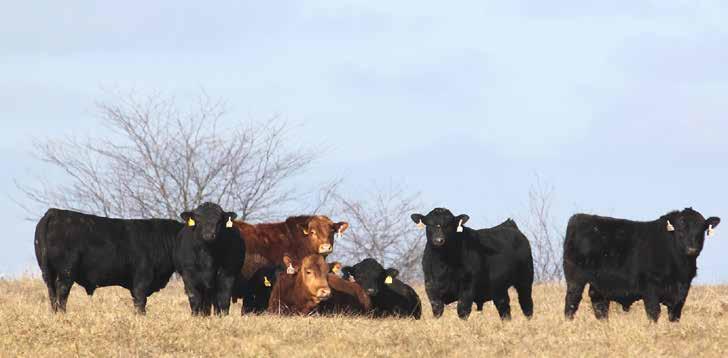
• Guaranteed Sight-Unseen Purchases!
• Free Trucking on every bull! No fine print!
• The best disposition & soundness sort!
• Extensive Data & Genomic EPDs!
• All Bulls Are Semen & Trich Tested!
• Videos of sale bulls the week before the sale! www. dvauction.com or www.seedstockplus.com

Chris Teutsch UK Research and Education Center at Princeton
In the southeastern United States, pasture productivity is commonly limited by low soil fertility. High fertilizer prices often restrict applications of commercial fertilizer in low input grazing systems, especially on leased pastureland. An alternative to conventional fertilizer may be to use bale grazing to distribute fertilizer nutrients contained in hay (Table 1). However, little replicated data is available to substantiate the positive impacts of bale grazing.
In 2022, a long-term bale grazing study was started at the University of Kentucky Research and Education Center in Princeton. The objective of this project was to document the impact of bale grazing on changes in soil fertility. Forty bales with an average weight of 822 lbs./bale were uniformly distributed in a 10-acre pasture (Figure 1). Nutrient content of the hay bales can be found in Table 1. The pasture was stocked with 61 cow-calf pairs on March 7, 2023, and animals were removed on March 20, 2023. Hay rings were used to minimize feeding losses, and temporary electric fencing was utilized to allocate enough hay for a 2 to 3-day period.
Soil nutrient levels were documented at the start of the study and one year later by sampling every 20 ft. along two permanent transects that transversed the pasture (Figure 2). Dung pile density was also documented by counting dung piles in 30 ft. by 40 ft. rectangles that were randomly selected in three pasture zones defined by distance from water. Impact area around bales was quantified and residual hay was collected, dried and weighed (Figure 3).
Following bale grazing, the area covered by hay was 255 sq ft. (Table 2). The total impact area around each bale was 682 sq ft. (Figure 3). Hay remaining after bale grazing was 89 lbs. DM per bale (Table 2). This was approximately 12% of the initial bale weight.
Dung pile distribution is shown in Table 3. Following bale grazing, there were more than 1,500 dung piles/acre. The average dry weight of dung piles was 0.70 lb./pile (data not shown). This resulted in an average manure deposition of more than 1,000 lbs. dried dung/acre.
One season of bale grazing increased soil test P, K, Ca, Mg, and Zn (Table 4). Soil test P increased from 18 to 22 lbs./A (P < 0.001) while K increased from 125 to 161 lbs./A (P < 0.001). The initial results of this study indicate that bale grazing may have the potential to change soil test nutrient levels more rapidly than expected. Stay tuned for year two data.
one cycle of bale grazing.



This month’s featured video is “Bale grazing for biological fertility and healthier pastures” by Greg Halich. This presentation was given as part of the 2024 Heart of America Grazing Conference held on Oct. 15-17 in Elizabethtown. It is available at https://www.youtube.com/ watch?v=t8Z0SsHD25A.
FORAGES AT KCA • Jan. 17, 2025 Owensboro Convention Center, Owensboro
2024 ALFALFA AND STORED FORAGE CONFERENCE • Feb. 25, 2025 • Fayette County Extension Office, Lexington • from 8 a.m. to 3:30 p.m. Local Time More information available at https:// forages.ca.uky.edu/ and clicking on “UPCOMING EVENTS”.
This month’s featured publication is: “Soil Testing Hayfields and Pastures” by Chris D. Teutsch and Edwin L. Ritchey. It is available online at https://forages.ca.uky. edu/sites/forages.ca.uky.edu/files/agr252. pdf or visiting your local extension office.
Join polywire correctly. If you use polywire, you will eventually have to repair breaks or join rolls. It is important to have good conductivity. Simply tying a knot is NOT sufficient. To ensure good conductivity, separate 2 inches of the metal strands from the poly material by melting plastic away with a lighter or match. Then tie the polywire together so that the exposed ends match up and twist them together. This will optimize conductivity and ensure maximum animal control.
• Remove animals from wet pastures to limit pugging and soil compaction.
• Feed best quality hay to livestock groups with the highest nutritional requirements. Supplement poor quality hay as needed.
• Feed hay on your poorest pastures to improve soil fertility and organic matter.
• Move feeding points around the pasture to improve nutrient distribution.
• Consider bale grazing to improve nutrient distribution. See this month’s featured video.
• Buy clover seed early since supplies will likely be tight this spring. Store seed in a cool, dry place until frost seeding begins in February.
• Inspect and repair seeding equipment.
• Consider purchasing a GPS guidance system for improving your frost seeding precision.

Michelle Arnold DVM (Ruminant Extension Veterinarian, UKVDL)
“Neonatal” calf diarrhea is defined as scours occurring within the first three weeks of a calf’s life. Viruses (rotavirus, coronavirus), certain bacteria (E. coli K99; Clostridium perfringens Types A and C, Salmonella spp.) and the protozoan parasite Cryptosporidium parvum are the most common causes in beef cattle operations. Controlling rotavirus, coronavirus, Clostridium perfringens Type C, and E. coli K99 scours through vaccination can significantly reduce calf sickness and death loss when given correctly. Scours vaccines are formulated to be given to pregnant cows and heifers during the third trimester so they will make the specific antibodies against the pathogens that cause diarrhea while colostrum is being formed. It is important to remember that scours vaccines given to pregnant cattle will only work if an adequate amount of good quality colostrum is consumed by her newborn calf within the first 12 hours (preferably the first 6 hours) of life. If unable to vaccinate the pregnant females in the herd, a variety of products can be given to newborn calves to help reduce the risk of sickness and death from scours.
The three most popular vaccines available for use in pregnant cattle are ScourBos®9 and 4 (Elanco), ScourGuard®4KC (Zoetis) and Guardian® (Merck). The first time scours vaccines are used, a two-shot series must be given in the third trimester of pregnancy consisting of a first or “primary dose” followed by a booster dose. After the first year, just one annual revaccination in late gestation is required every year throughout the cow’s reproductive life. Vaccination timing is critical to stimulating and optimizing antibodies in colostrum. If cows are vaccinated too early in pregnancy, the antibody response may start to fall off prior to the colostrum being made. If you vaccinate too late, the colostrum may already be produced before an antibody response is mounted. Which product is chosen often depends on when cattle will be worked. Scour
Bos® is administered earlier during pregnancy; ScourGuard® is used latest in gestation, and Guardian® is inbetween these two options. Obviously, not all calves will be born the first week of calving season, but plan to give the scours vaccine based on when the first calves of the season are expected. Consider administering an additional dose to females who have not calved within two months of receiving their scours vaccine.
It takes some planning to vaccinate correctly; timing is critically important when selecting the correct product for your operation:
1. For pregnant heifers (or cows) receiving their first or “primary series” of scours vaccine, manufacturers give a date range for one dose and a set date for the other dose that varies depending on vaccine chosen. Note that Guardian is the only one administered subcutaneously.
• Scour Bos®9 –Administer the first dose (2 ml IM) 8-16 weeks prior to calving and booster with Scour Bos® 4 given four weeks prior to calving;
• Guardian®- Administer the first dose (2 ml SQ) 12 weeks before calving and the second dose 3-6 weeks later;
• ScourGuard® 4KC-Adminster first dose (2 ml IM) 6-9 weeks before calving and give the second dose three weeks later.
2. Cows (Annual revaccination)-
• Scour Bos®9 –Administer 8-10 weeks prior to calving season.
• Guardian®-Administer 5-7 weeks before calving season.
• ScourGuard® 4KC-Administer 3-6 weeks prior to calving season. If the cow herd is not vaccinated and a calf scours problem develops, there are several products available to administer to newborn calves. The First Defense® product line includes the Tri-Shield® gel tube, Dual-Force®
gel tube, First Defense® bolus and First Defense Technology® bulk powder. These products are antibodies given by mouth as quickly as possible after birth. First Defense® makes their products by collecting antibodyrich colostrum that is purified and concentrated, then standardized to guarantee antibody levels for each dose. These antibodies bind directly to bacterial and viral antigens, ideally before they can enter and harm cells in a calf’s gut. These are not vaccines, so the calves are not required to trigger an immune response for protection. Although these antibodies will provide immediate protection in the gut, they are much more effective when given at the same time as good quality colostrum. Be aware of the label claims when using First Defense products (see Table 1); not all pathogens are covered by every product. First Defense® Tri-Shield® gel offers the broadest coverage, specifically aiding in the reduction of mortality (death) and morbidity (sickness) from scours caused by E. coli K99 and coronavirus while also reducing the severity and duration of scours caused by rotavirus. Interestingly, the First Defense® gels have an added blue dye that renders the calf feces green, allowing the producer to know the gel has gone through the calf’s GI tract. For an economical option, First Defense® offers a nutritional supplement powder with the same ingredients as the boluses, and it is shelf stable in a resealable bucket. One level scoop is mixed with fresh or thawed colostrum until completely dissolved and then fed to the newborn calf.
There are also commercially available vaccines designed to be administered to the newborn calf for protection from certain viruses. Calf-Guard®, manufactured by Zoetis, is an older product that contains attenuated (modified live) strains of bovine rotavirus and bovine coronavirus. It can be administered either by injection to a pregnant cow within four weeks of calving or to newborn calves by mouth before nursing to help protect

Table 1: Retrieved from : https://firstdefensecalfhealth.com/dual-force-bolus-gel/
calves from scours caused by rotavirus or coronavirus. A brand-new product, Bovilis® Coronavirus (Merck), is an intranasal vaccine administered to healthy calves 3 days of age and up to reduce the duration and severity of diarrhea due to bovine coronavirus (Figure 1).
Preventing calf scours is much more about management than simply administering a vaccine. Cow nutrition during and after gestation, careful monitoring of the calving process, and environmental factors all contribute to a successful start. The cow’s diet must provide adequate energy, protein and trace minerals to meet her needs during gestation and lactation, especially during winter. Remember, up to 80% of fetal growth occurs in the last 50 days of gestation and colostrum production ramps up during the final 4-6 weeks of pregnancy. Monitor body condition scores and be ready to offer supplemental feed to maintain a BCS at calving of 5 in mature cows and 6 in heifers. A nutritionally deprived dam will produce poor quality and quantity of colostrum, have less energy to deliver a calf quickly, and will be slow to rebreed. Calves born to energy deficient dams will be slow to stand and nurse.
Monitor and be ready to assist with calving early as necessary, especially with heifers. Make sure calves start nursing as soon as possible after calving, keeping in mind that calves should stand within 30 minutes of delivery and nurse within 30 minutes of standing. If in doubt, use a good quality colostrum replacer and feed the calf at least twice during the

Figure 1: Retrieved from https://www.merck-animal-health-usa.com/species/cattle/products/ bovilis-coronavirus
first 6 hours of life. Once the calf has received colostrum, it is still important to prevent the “bad bugs” (pathogens) in the environment from overwhelming the calf’s immune system. Over time, calves infected earlier in the calving season are “pathogen multipliers” and become the primary source to younger calves. Calf scour pathogens will build up exponentially in the environment as the calving season progresses.
Poor sanitation, cold, wet weather and overcrowding all contribute to a higher risk of disease, especially conditions in calving and maternity areas. Exposure to bacteria, viruses and protozoa occurs through direct entry of manure to the mouth of a calf by contact with manurecontaminated teats, soiled bedding, and through self-grooming. Calving in the same area for an extended
period of time greatly increases the disease risk to the youngest calves, especially in wet or muddy conditions. If possible, pregnant cows close to calving should be rotated onto clean pastures while cow-calf pairs remain on the old pasture. If calving in a barn or shed, the calving area should be kept as clean and dry as possible with frequent changes of bedding to remove the build-up of organisms. Make every effort to get the cow and newborn calf out of the barn quickly to lessen the chances of infection. Even the best calving management practices will have no effect if the first thing a calf ingests is manure from the calving area. Consult with your veterinarian on ways to address a calf scours problem and the best choice of vaccines for your operation.
The UK Veterinary Diagnostic Laboratory has an excellent test to diagnose the cause of calf diarrhea. A small sample of scours (in a leakproof container) from a calf that has not been treated for diarrhea with antibiotics is the best sample to run the test. The “Calf Diarrhea Panel” is a PCR assay that detects the nucleic acids in bovine coronavirus, rotavirus, E. coli K99, Salmonella and Cryptosporidium. Results are available within 2-3 days and costs $62.75 + $10 Accession Fee. Visit the website at https://vdl. uky.edu/ for more information or call (859) 257-8283.
The products described are for educational purposes only and should not be considered an endorsement by the University of Kentucky.
Doug Parke Kentucky Simmental Association

The Kentucky Beef Expo was started by the Department of Agriculture, Kentucky Beef Expo leadership and the Division of Shows and Fairs 39 years ago. With Kentucky being the largest beef cattle producing state east of the Mississippi River, these three entities felt a strong need for special shows and sales to be held at the North American Livestock International Facility to help cattle breeders. Kentucky Farm Bureau joined the Beef Expo team in 1998 to support the show and sale every year. The Simmental breed is extremely grateful for KFB’s, the Beef Expo board, and the volunteers’ dedication to this three-day event.
The Beef Expo became the place for the seedstock industry to purchase genetics to improve their operations. The goal was to improve genetics, enhance marketing and gain knowledge of the latest trends in the industry. The Kentucky Department of Agriculture worked and continues to work diligently to improve the outstanding beef cattle herds across the state.
At the very first show, Simmental breeders were at the forefront due to several serving in leadership positions. Many Simmental breeders willingly participated in the expo to advance the breed, genetics, beef operations and the Simmental customer base. Sales management firms and breeders throughout the state were responsible
for marketing strategies to secure top-end Simmental genetics for the event. Simmental genetics are one of Kentucky’s strengths due to the numerous herds across the state; because of this, qualified and elite judges have always been selected to evaluate livestock during the show/sale. Upon evaluation and the completion of the show, potential buyers purchased Simmental cattle at the sale on the first Saturday in March. Since the very first expo, breeders and junior members always look forward to taking part in the show and sale at the Kentucky Farm Bureau Beef Expo every year.
Throughout the history of the Beef Expo, the Simmental breed has had, on average, 24 to 36 consignors and has been sold to buyers from six to 14 different states. Still, today, the Simmental sale continues to be one of the higher grossing sales. Although the market has fluctuated, the Simmental breed still remains in high demand from seedstock and commercial producers. In the 2024 sale, the highselling, champion bull, consigned by Rocking P Farm- a long-time exhibitor at the Beef Expo- sold for $13,000 to Trent Sporeleder from Indiana. Also, in 2024, Lot 33, a fall open who was consigned by Stephens Cattle and gained the title of reserve champion female, sold for $8,200. Furthermore, other highlights from the 2024 sale include an open heifer, “NJM Desa
Rae,” who sold for $6,800 to a Texas family and the champion bred female, consigned by Oleo Ranch and sired by “WLE Copacetic,” who sold for $4,600 to Dean Clubb.
In 1998, the All-Breed Pen Sale was established. This sale was unique because cattle were required to not be halter-broke or registered. The cattle were sold in pens, and buyers were able to select the number of head they would like to purchase out of the pen. This sale still takes place today, and there are many Simmental-influenced lots. Each breed, which runs through this sale, is paid $8,000 in premiums from KDA. The KSA is proud to match half of that amount to assist the consignors and the show.
Brian Swain, Kentucky Simmental Association president and consignor says, “The Kentucky Beef Expo has always been a great place for Simmental breeders of Kentucky and surrounding states to showcase and market high quality cattle with outstanding genetics. The pen sale offers additional quality that doesn’t have to be haltered. The shows on Saturday and Sunday are always very competitive and enhance the overall quality of the event for Simmental enthusiasts and breeders.”
I know, as DP Sales Management, the Kentucky Simmental Association, board members, Kentucky Farm Bureau, and cattle breeders find the expo’s shows and sales extremely beneficial. This year, to further expand the Beef Expo community, the Kentucky Cattlemen’s Association and the Livestock Marketing Association have committed to being involved and supporting this event.
To find ways to personally support this event, please consider becoming a consignor or buyer; register your Simmental cattle and/or genetics for the Kentucky Farm Bureau Beef Expo! The Kentucky Simmental Association President, Brian Swain, any member of the sale committee and DP Sales Management are here to assist Simmental consignors.

















Rachel Cain Membership & Communications Coordinator
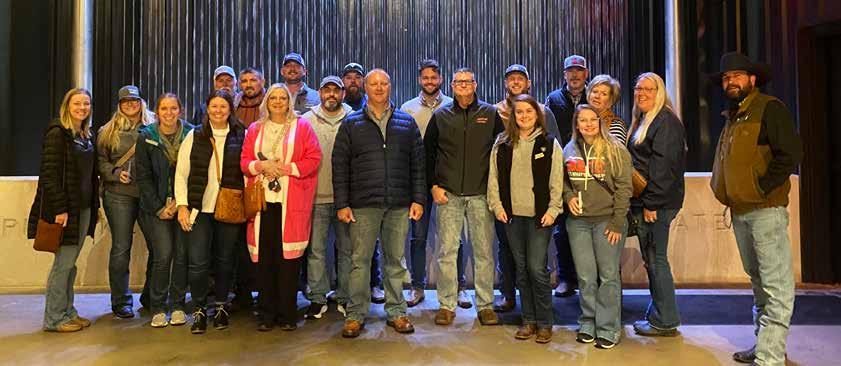
Class X of the Leadership Development Program recently completed its second session, which provided participants with valuable industry insights, communication skills and networking opportunities. The session kicked off with a tour of Creation Gardens. Duncan Paynter guided the class through the production floor, while John Thomas, vice president of proteins, provided insights into the company's business model and history. The group engaged in discussions about the challenges faced within the food supply industry and how those same challenges also impact their own operations.
In the afternoon, participants began a two-day training session with Chandler Mulvaney, NCBA director of grassroots advocacy and spokesperson development. The class explored their individual roles in the beef industry and what drives them, as ways to develop their personal “why.”
On the second day, Class X visited Kentucky Farm Bureau in Louisville. Joe Lowe from Oak Hollow Angus led a presentation emphasizing the importance of sharing their stories with family, friends, consumers and fellow producers. He highlighted the oftenunrecognized influence that beef producers have on those around them when it comes to perception of the industry.

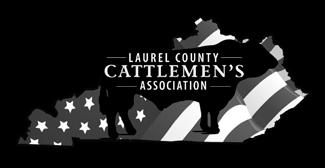
In the afternoon, the class participated in mock interviews at the Kentucky Farm Bureau studio. Facilitated by Mulvaney, each participant answered challenging questions on topics such as production practices, climate change, animal welfare and nutrition. The session provided valuable practice for communicating effectively and confidently in an interview setting.
On day three of the program, Class X visited Cedar Creek Beef Company in Shepherdsville. Cedar Creek Beef Company is owned and operated by fellow class member Jewett Borden III. Borden utilizes the Santa Gertrudis breed to produce a locally grown and fed beef product for consumers. In addition to selling through the storefront on the property, Borden also partners with local restaurants and businesses to move his product. Class participants discussed the business model of Cedar Creek Beef and how it has evolved over the years to better meet the needs of the customer, which is Borden’s No. 1 goal.
The last stop of the session was a tour of James B. Beam Distilling Company in Clermont. The group was led through a tour of the distillery and discussed how the bourbon and beef industries are related. The class concluded the day with a great meal at The Kitchen Table, a restaurant inspired by the Beam family kitchen. They enjoyed steaks from Cedar Creek Beef Company and discussed the distilling business with master distiller, Fred Noe.
Class X is funded through the Kentucky Cattlemen’s Foundation. Session Three is scheduled for February 2025 in Frankfort.



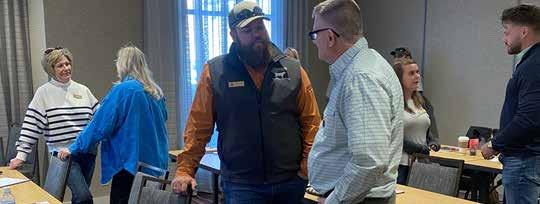


* MEMBERSHIP YEAR 10/1/24– 9/30/25
NAME SPOUSE NAME FARM NAME
*Payments of KCA membership dues are tax deductible for most members as an ordinary and necessary business expense. However, charitable contributions of gifts to KCA are not tax deductible for Federal Income Tax purposes. Due to new IRS regulations, $2.24 of your dues would not be deductible. Approximately $12 of your dues will go towards the monthly publication Cow Country.
PLEASE CHECK THE MEMBERSHIP(S) YOU WOULD LIKE TO JOIN:
KCA MEMBERSHIP ($30/YR) NEW RENEWAL
Membership dues are $30 unless otherwise listed below
KCA COUPLE MEMBERSHIP
To add your spouse, please add $15 to your KCA Membership
KENTUCKY JUNIOR CATTLEMEN’S ASSOCIATION ($10/YR) NEW RENEWAL
I WOULD LIKE ADDITIONAL INFORMATION ON THE YOUNG PRODUCER’S COUNCIL
TOTAL MEMBERSHIP:
$ KCA
$ KJCA
TOTAL CONTRIBUTIONS:
$ CATTLEMEN’S FOUNDATION DONATION (voluntary)
TOTAL AMOUNT ENCLOSED:
$ ALL DONATIONS TO KCF ARE TAX DEDUCTIBLE
COUNTY DUES
Dues are $30 except for the counties listed below.
Allen...............................$40
Anderson........................$25
Bourbon.........................$20
Boyle ..............................$35
Bullitt..............................$20
Butler..............................$25
Franklin ..........................$25
Louisville Area ................$20 (Jefferson, & Spencer) Magoffin .........................$20 Menifee ..........................$25
Mountain........................$25
(Breathitt, Floyd, Knott, Lee, Leslie, Letcher, Morgan, Owsley, Perry & Wolfe)
Highlands .......................$20 (Boyd, Johnson, Lawrence, & Martin) Hopkins ..........................$35 Laurel.............................$35
Woodford......................$25
IF YOU WOULD ALSO LIKE TO JOIN THE NATIONAL CATTLEMEN’S BEEF ASSOCIATION The NCBA is now a State Marketing Partner with the KCA. You can pay your dues to both organizations with one check, at the same time.
+

Amelia Carter Director of Industry Relations
As part of its ongoing commitment to promote Kentucky’s beef industry, the Kentucky Beef Council has been visiting stockyards across the state to engage with producers, learn more about their operations, and gather insight on how the Checkoff program can best serve the beef community.
Over the past several months, I’ve had the privilege of visiting several stockyards across the state and meeting with cattle producers who are passionate about raising quality beef and supporting Kentucky’s agricultural economy. Each stop has been an opportunity to hear firsthand about the challenges and successes that shape the day-to-day operations of our hard-working producers.
The goal of these visits is twofold. First, to better understand how the KBC can provide additional resources, tools and support to producers who are tirelessly working. Second, to ensure that the Checkoff program, which is funded by beef producers, continues to serve as a valuable investment in Kentucky’s beef industry. These visits allow for open conversations and exchanges of ideas that are critical for enhancing the impact of the program and fostering collaboration among Kentucky’s cattle producers.
We are grateful for the opportunity to visit these facilities and for the trust that producers have placed in the Beef Council to represent and promote their interests. I would also like to express my sincere gratitude for the support we’ve received from producers who have joined us on these visits. Their willingness to engage and share their insight regarding the Checkoff has been invaluable in helping us strengthen connections within the industry and

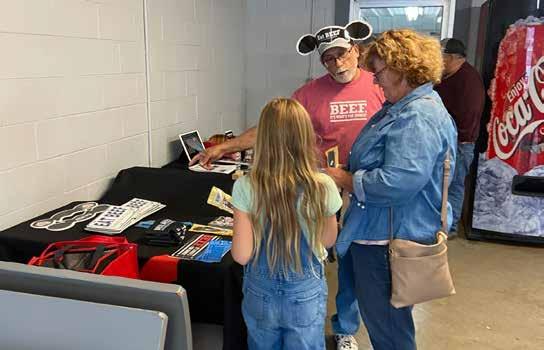


ensure we are serving the needs of Kentucky’s beef community. A special thank you goes to Gary Ford, Jake Harrod, Jennifer Hickerson, Mitchell Logsdon, Ryan Miller, Donovan Pigg and Mike Ravencraft for their support and participation.
The KBC’s stockyard tour is far from over. With many more visits scheduled, we are excited to continue building relationships and ensuring that Kentucky’s beef producers have the support and tools they need to succeed.
The Kentucky Beef Council is proud to announce that the participants have been selected for the Beef Advance Program, a new leadership development initiative tailored to enhance advocacy, networking and leadership skills for those passionate about the beef industry. Designed to empower participants with the tools to lead and influence, Beef Advance will invest in the industry's future by fostering the growth of passionate and informed advocates for the beef community.
This year’s cohort of participants, chosen for their dedication and potential, include:
• Allan Bryant
• Kendra Childress
• Hannah Grace Childress
• Josh Geron
• Amanda Hall
• Jake Harrod
• Matthew Jeffiers
• Ally Jones
• Jenny Price
• Eric Ross
• Michelle Simon
• Conan Stamenkovic
• Rachel Westerman
• Susan Zoglmann
• Wayne Zoglmann
The program will launch in January 2025 in Owensboro, leading directly into the Kentucky Cattlemen’s Association’s Annual Convention. This immersive opening session will provide participants with opportunities to engage with industry leaders, learn from expert speakers and begin building the foundation for a year of growth, collaboration and impactful advocacy.
Congratulations to these exceptional individuals on their selection! The Kentucky Beef Council wishes them great success as they embark on this transformative journey.
Stay tuned for updates throughout the year as the inaugural Beef Advance class progresses through the program!


Rachel Cain
Membership & Communications Coordinator
Kentucky Team Beef had another incredible year of running, advocating and enjoying delicious beef! This team of 50 dedicated runners is committed to healthy lifestyles, combining physical activity with nutrient-rich diets. They strongly believe in the nutritional benefits of lean beef and its vital role in fueling their training.
Team members come from diverse backgrounds. Whether they're farmers, industry professionals, avid cooks or food enthusiasts, they all share one thing in common — they love beef! Throughout the year, members engaged in educational activities like webinars, farm tours, and stockyard visits. These experiences help them become stronger advocates for the beef industry and for the 32,000 Kentucky beef farm families they proudly represent.
In 2024, Kentucky Team Beef runners represented the team at over 40 races across Kentucky, the United States and even internationally! The team's biggest event of the year was the Kentucky Derby mini/ Marathon, where 24 runners raced in their Team Beef jerseys. This race draws over 12,000 participants from around the world, plus spectators. Volunteers from the team set up a booth at the Race Expo, where they answered questions about beef production, cooking safety and nutrition. This event provides runners a perfect platform to discuss the benefits of beef in a diet with fellow athletes!
2025 Team Beef is already gearing up for another fantastic year. Happy Running, and Go Team Beef!
Contact Rachel Cain at rcain@kycattle.org to learn more!


Jake Harrod KBN Program Coordinator
The programs that we at the Kentucky Beef Network put on are designed to help Kentucky farmers increase revenue on their farms through new management practices and concepts. One of the ways we try to increase a farmer’s revenue is through marketing opportunities. By this, I mean the five value-added sales that we support across our state. Reading this you may wonder what “value-added” means. Value-added applies to how a producer goes about marketing their cattle by trying to add more value to the animal they are selling.
During December, over 4,500 feeder calves were sold across these five sales in the span of two weeks. These sales were the Owensboro CPH-45 sale, the KY-TN CPH Advantage sale, the Certified Hereford Influenced Feeder Calf sale, the Profit Thru Performance Feeder Calf sale and the Charolais Influenced Feeder Calf Alliance sale. The purpose behind these sales is to give farmers the opportunity to market cattle in large uniform lots, gain premiums based on better management, and build the reputation and value of Kentucky cattle. These sales give farmers, who may not have many calves, the opportunity to receive better premiums and benefits that comes from selling load lots. Additionally, these sales operate under guidelines that all participants must follow. This includes specific health
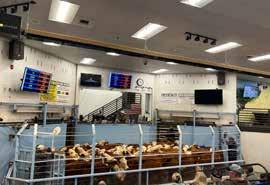
management protocols, feeding practices, and owned and weaned between 45 and 60 days. Each one of those management practices increase the value of the calves on their own, but all of them together add even more value. All this creates a higher quality calf that buyers are willing to pay more for. Then when you take a large number of these calves and put them together into uniform groups, this increases their value even more. When buyers see that the calves have been weaned for an extended period, had good health management, know how to eat, and come from an owner they know, this all adds together to create a much more valuable product. To be a part of these sales gives these farmers greater opportunities and benefits than they would have selling the animals on their own.
Adding value to your calves is a great way to increase your farm’s revenue. It can be as easy as vaccinating or weaning your calves. But if you want to get the absolute most out of your calves, I would recommend looking into the guidelines of the value-added sales I mentioned earlier. If you would like to hear more about the variety of value-added sales that we support or if you would like to look into joining one of the aforementioned sales, please visit our website https://www.kybeefnetwork.com/ or visit our Facebook page @Kentucky Beef Network.






Dan Miller Industry Coordinator, Kentucky Beef Network
Welcome to 2025! I hope you enjoyed Christmas and New Years with family and friends. It is always good to start the new year off with the rest and reset of the holidays.
During the past month at the farm, we have been catching up on some projects that never seem to make it to the top of the list. A water leak caused our contractor to mobilize and address the urgent issue of water running down the side of the hill. In typical Eden Shale fashion, the water leak was coming from an old galvanized water line that didn’t run to anything, and previously we didn’t know it existed.
With the water line fixed, we had a list of other things for our contractor to do while he was onsite. We spread seven loads of rock onto existing winter feeding sites. We are developing a winter feeding structure for the heifers in which we procured free road millings from a recent road widening project near the farm. This structure is the last location that we still feed hay with hay rings and it will soon utilize a Bo Renfrow structure to feed hay with additional bunk space for grain and a creep area for the calves. It will also have incorporated a manure stack pad and windbreak structures for the animals.
Another project was completing an intermittent creek
crossing. The aforementioned road widening project took out our main alleyway going to the west side of the farm. Recreating the alley proved to be too expensive, so instead we created a crossing from one field into the adjacent paddocks. The contractor utilized existing concrete that was removed from the heifers feeding site and placed it as armoring for the new crossing. It turned out nice, and it should protect the small stream channel from the occasional crossing of animals from one side of the farm to the other.
Other projects included adding a 3,000 gallon tank to the water harvesting system at the heifer barn. This will give us approximately 7,000 gallon capacity to water livestock, and it now has the dual purpose of being used to fill up our sprayer with harvested water using a 2 inch pipe. We have not tried the system yet, but initial calculations of the flow rate of a 2 inch pipe suggest that our 300 gallon sprayer can be filled in under 10 minutes. To compare, the garden hose with good pressure was taking approximately 50 minutes to fill the sprayer. That is a massive reduction of downtime while refilling the sprayer. I will give you an update once we start spraying in the spring.
I hope your new year is productive, and I look forward to seeing everyone at the KCA Convention in Owensboro.

Generally the Buyer is responsible for collecting the Beef Checkoff assessment from the Seller

However, both the Buyer and the Seller are responsible for seeing that the Checkoff is collected and paid. or pays $2 to
QUALIFIED STATE BEEF COUNCIL
Cattlemen’s Beef Board invests in national Checkoff programs, while Kentucky Beef Council invests in state programs.
If you are a producer from one of these seven states - Alaska, Connecticut, Maine, Maryland, Massachusetts, New Hampshire, and Rhode Island - you will remit directly to the Cattlemen’s Beef Board. If you have any questions regarding who is responsible for remitting the Checkoff assessment or how to remit payment, please contact your State Beef Council or the Cattlemen’s Beef Board at (303) 867-6304.
3 Exceptions to Beef Checkoff Collection: 1. Non-producer status: If a person (or company) owns cattle for 10 days or less, purchases the cattle to facilitate the transfer of ownership to a third party, and certifies that any Checkoff dollars due from the previous owner have been collected, then that person qualifies as a “Non-Producer” and the Checkoff assessment is not due when qualified cattle are resold. 2. Organic Exemption: In the 2002 Farm Bill, Congress created a process exemptiing organic producers from paying Checkoff program assessments. 3. Pre-Payment: Producers can also choose to “prepay” the Checkoff assessment when shipping cattle out of state for feeding and still retain ownership on the cattle. This allows the producer to direct half of the $1-per-head national Checkoff assessment to the beef council in the state where the cattle were raised, rather than the state where the cattle will be fed. Note: To claim any of these exemptions, the person selling the cattle must provide the proper ‘document’ to show that the Checkoff assessment is not due at the time of sale. Thus, the rule of thumb for all cattle sales is that the person paying the producer should collect either a “Dollar or a Document.”
LIVESTOCK MARKET - When cattle are sold through a livestock market or video market, the Market collects and remits the Beef Checkoff assessment.
CATTLE DEALER/ORDER BUYER - When cattle are sold to a Cattle Dealer or Order Buyer, the Dealer/Order Buyer collects and remits the Beef Checkoff assessment.
ANOTHER PRODUCER - Both the Buyer and the Seller are responsible for making sure that the Beef Checkoff assessment is collected and remitted. For clarity and consistency, we encourage the Seller to take on this compliance responsibility.
VEAL GROWER - When dairy calves are sold to a Veal Grower, both the Buyer and the Seller are responsible for making sure that the Beef Checkoff assessment is collected and remitted. For clarity and consistency, we encourage the Seller to take on this compliance responsibility.
CATTLE SHOWS AND FAIRS - When producers sell their animals at fairs or cattle shows (4H/FFA shows, Purebred cattle shows, etc.), the Organization that runs the sale collects and remits the Beef Checkoff assessment.
FEEDLOT - When cattle are sold directy to a feedlot, the Feedlot collects and remits the Beef Checkoff assessment.
PACKING PLANT - When cattle are sold to a packing plant, the Packing Plant collects and remits the Beef Checkoff assessment.
DIRECT-TO-CONSUMER BEEF SALES - When producers market their cattle as beef, the Producer is responsible for remitting the Beef Checkoff assessment.
According to the Paperwork Reduction Act of
an agency may not conduct or
person is
to a
it
to
The
for this
of
and
control
OMB control
collection is 0581-0093. The time required to complete this
collection is estimated to
per response, including the
one
for reviewing instructions, searching existing data sources, gathering and
the
and completing and reviewing the
of
The U.S. Department of Agriculture (USDA) prohibits discrimination in all its programs and activities on the basis of race, color, national origin, age, disability, and where applicable, sex, marital status, familial status, parental status, religion, sexual orientation, genetic information, political beliefs, reprisal, or because all or part of an individual’s income is derived from any public assistance program. (Not all prohibited bases apply to all programs.) Persons with disabilities who require alternative means for communication of program information (Braille, large print, audiotape, etc.) should contact USDA’s TARGET Center at (202) 720-2600 (voice and TDD). To file a complaint of discrimination, write to USDA, Director, Office of Civil Rights, 1400

KEVIN AND RACHEL BARRON
Crestwood, Ky
(502) 905-5851
rkbarron812@gmail.com

SWAIN SELECT SIMMENTAL 12113 Green Valley Dr. Louisville, KY 40243 swainselect.com swainselect@gmail.com facebook.com/swainselectsimmental

Fred & Phyllis: 502-599-4560 Chi & Angie: 502-287-2116

JUDY AND RONDAL DAWSON 1156 Buzzard Roost Road Shelbyville, KY 40065 502-593-5136 • jrdawson22@outlook.com

JEROD METZGER • 270-779-6260

ROCKING P LIVESTOCK 8308 Orangeburg Road Maysville, KY 41056
Chan: 606-584-7581
Keith: 606-584-5626
rockingplivestock@maysvilleky.net
BRIAN & HEATHER SWAIN 3906 Pottertown Road Murray, KY 42071 • 270-293-4440
wksbswain@murray-ky.net


SIMMENTAL AND SIMANGUS BULLS FOR SALE
1939 Huntertown Road
Versailles, KY 40383
BULLS FOR SALE
Chris Allen 859-351-4486 callenuky@hotmail.com
Dr. Henry Allen 859-229-0755


The Simmental cow can handle any environment.
She’s built to last in heat, fescue or high altitudes. And thanks to the breed’s built-in adaptability, you can match Simmental genetics to your environment – SimAngus,™ SimAngus HT, Simbrah or proven Simmental genetics.
Meet America’s all-purpose cow – gentle and consistent, with calves that give the heterosis boost commercial cattlemen need to stay profitable.
406-587-4531 • simmental.org

BRET AND LAURA JACKSON 859.533.3718 or 859.707.7200
BRET & LAURA JACKSON Paris, Kentucky (859) 533-3718 (859) 707-7200

BOYD BEEF CATTLE
6077 Helena Road
Mayslick, KY 41055
Charlie Boyd II: (606) 584-5194
Blake Boyd: (606) 375-3718 www.boydbeef.com cboyd2@maysvilleky.net
BURTON & SONS ANGUS
Joe D. or Karen Burton
BOYD BEEF CATTLE 6077 Helena Road Mayslick, KY
Secretary/Treasurer:

BRANCH VIEW ANGUS
927 Old Liberty Pike • Hustonville, KY 40437 (859) 238-0771 • www.branchviewangus.com
927 Old Liberty Pike • Hustonville, KY 40437 (859) 238-0771 • www.branchviewangus.com

480 Hominy Hill Rd. Nancy, KY 42544
Joe: (606) 305-3081
Located 15 miles West of Somerset • klburton01@windstream.net
Bulls & females sold private treaty. Inquiries Welcome. Sell only what we would buy. Data driven since 1981.
FALL CREEK ANGUS
448 Corder Farm Road
Monticello, KY 42633
Ronnie Corder (606) 348-6588
HILL VIEW FARMS
Jimmy Gilles
5160 Lee Rudy Road
Owensboro, KY 42301 (270) 929-5370 jcgilles86@gmail.com
OLD BARK FARM
370 Ferrill Hill, Buffalo, KY 42716
Kenley Conner (502) 905-7825
Registered Angus Cattle
ST. CLAIR FARMS REGISTERED ANGUS
Eric & Sherry St. Clair
13433 Falls of Rough Road Falls of Rough, KY 40119
Home: (270) 257-2965 • Cell: (270) 617-1079 www.stclairangus.com
Performance Tested Bull & Female Sale April 2020

TWIN CREEK FARM
HILL VIEW FARMS
Shawn, Melissa, Devin & Dylan Gibson (270) 337-3072 or (270) 692-5304 Dennis & Emily 270/337-2128 or 270/402-4338
Jimmy Gilles 5160 Lee Rudy Road Owensboro, KY 42301 (270) 929-5370 jcgilles86@gmail.com

42301 (270) 929-5370 jcgilles86@gmail.com

James S. & LuAnn Coffey, Donald & Donna Coffey
Annual Production Sale- 2nd Saturday in April
James S. & LuAnn Coffey, Donald & Donna Coffey Annual Production Sale- 2nd Saturday in April

COFFEY ANGUS FARMS
BURKS CATTLE CO. 531 Rick Rd. Park City, KY 42160
661 Hopewell Road Liberty, KY 42539
Eddie Burks • (270) 991-6398 www.burkscattle.com
Matt Coffey: (270) 799-6288
Dewey Coffey: (606) 706-2699
BURTON & SONS ANGUS
Genetics for Maximum Profitability since 1984
Joe D. or Karen Burton
480 Hominy Hill Rd. Nancy, KY 42544
Joe: (606) 305-3081

Located 15 miles West of Somerset • klburton01@windstream.net
GREAT MEADOWS ANGUS ASSOCIATION
Bulls & females sold private treaty. Inquiries Welcome. Sell only what we would buy. Data driven since 1981.
COFFEY ANGUS FARMS
661 Hopewell Road Liberty, KY 42539
Dale Brown, President 292 Pea Ridge Road Stamping Ground, KY 40439 859-940-8437 www.greatmeadowsangus.com
Matt Coffey: (270) 799-6288
Dewey Coffey: (606) 706-2699
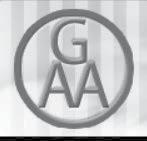
Genetics for Maximum Profitability since 1984
DAVIS BEND FARMS
LYNN CREEK FARMS
2315 Davis Bend Road Canmer, KY 42722
Kris and Sara Lynn 2184 Bardstown Rd Springfield KY 40069 573-721-6663
timmothyljeffries@gmail.com www.davisbendfarms.com Tim: (270) 528-6605 • Leslie: (270) 528-6435

FALL CREEK ANGUS
APS ANGUS
448 Corder Farm Road Monticello, KY 42633
Ronnie Corder (606) 348-6588
4040 Taylorsville Rd Taylorsville, KY 40071
Gordon Schubert
502-477-2637 • 502-548-8440
HAMILTON ANGUS FARMS

Anne Patton Schubert
502-477-2663 • 502-548-2359
Eddie Hamilton 2142 Stilesville Road Science Hill, KY 42553 edjohami@aol.com (606) 271-1286 Bulls and Females for Sale
TRIPLE D ANGUS
Nathaniel & Darla Denham
HERITAGE FARM

Nathaniel(Bub), Sarah, Ashley Denham (606) 423-2457 • (606) 875-0780 tripledangus.com
Tom McGinnis 1024 Hinkle Lane • Shelbyville, KY (502) 633-1634, home • (502) 633-5100, work (502) 655-0164, cell
PLEASANT HILL FARMS
PLEASANT HILL FARMS
Gil, Mary, Corbin, Caroline, and Catherine Cowles 500 Rockfield Richpond Road Rockfield, KY 42274 (270) 843-9021 • Fax (270) 843-9005
Gil, Mary, Corbin, Caroline, and Catherine Cowles 500 Rockfield Richpond Road Rockfield, KY 42274 (270) 843-9021 • Fax (270) 843-9005 Located 7 miles west of Bowling Green, 1/2
BURKS CATTLE CO. 531 Rick Rd. Park City, KY 42160
JOHNSON FARMS ANGUS
Angus Bulls & Females Slaughters, KY
Keith: (270) 635-0723
Eddie Burks • (270) 991-6398 www.burkscattle.com
Reese: (270) 635-1137
LYNN CREEK FARMS

DUTCH CREEK ANGUS FORAGE GENETICS
Kris and Sara Lynn 2184 Bardstown Rd Springfield KY 40069 573-721-6663
Doug and Susan Schlosnagle (502) 706-0008 DutchCreekAngus.om
MT. MORIAH ANGUS FARMS
Bob, Kathy, Rob, and Janna Clark (859) 748-5558 1446 Kennedy Bridge Rd. Harrodsburg, KY 40330 Bob: (859)339-2610 • Rob: (859)612-1594 mtmoriahfarms1@gmail.com www.mtmoriahangus.com
HERITAGE FARM
Tom McGinnis
1024 Hinkle Lane • Shelbyville, KY (502) 633-1634, home (502) 633-5100, work (502) 655-0164, cell
FOUR KINGS ANGUS
250 Bright Leaf Dr. • Harrodsburg, KY 40330
Cary & Kim King Carymking@yahoo.com • fourkingsangus.com

Jacob
Owner-Operator (859) 583-7134 jacob.tamme@gmail.com www.tammevalley.com

Cary Cell: (859) 613-3734 • Colby Myers - Purebred
MT. MORIAH ANGUS FARMS
OLD BARK FARM
370 Ferrill Hill, Buffalo, KY 42716
Kenley Conner (502) 905-7825
Registered Angus Cattle
Bob, Kathy, Rob, and Janna Clark (859) 748-5558 1446 Kennedy Bridge Rd. Harrodsburg, KY 40330 Bob: (859)339-2610 Rob: (859)612-1594 mtmoriahfarms1@gmail.com www.mtmoriahangus.com
Nathaniel(Bub), Sarah, (606) 423-2457 • (606) tripledangus.com

TWIN CREEK FARM Shawn, Melissa, Devin (270) 337-3072 or (270) Dennis & Emily 270/337-2128 or 270/402-4338
SMITHLAND ANGUS FARM
4437 East Hwy 80 Russell Springs, KY 42642
4040 Taylorsville Rd Taylorsville, KY 40071 Gordon Schubert 502-477-2637 • 502-548-8440 Anne Patton Schubert 502-477-2663 • 502-548-2359
Henry Bryan, Melissa, Bryanna and Blane Smith 606-271-7520 bmsmith@duo-county.com
WHITE FARM
Tim and Amy White 3664 Military Pike Lexington, KY 40513
Home: (859)223-0326
Tim: (859) 509-5401 Amy (859)227-2552 whitefarm4@twc.com

Located 7 miles west of Bowling Green, 1/2 mile off Hwy 68/80


Shayna Gibson, Secretary/Treasurer
www.kentuckyangus.org • kyangusassociation@gmail.com • @kyangusassoc • @kyangusassoc • @kyangusassociation
1. She must be at least 16 years of age and not over 21 years of age by January 1 of current year.
2. She must not be, nor have ever, been married.
3. She must be a resident of Kentucky.
4. She must be a member of the Kentucky Junior Angus Association for 2 years.
5. She must present a signed statement of consent from her parents or guardian to enter the contest.
6. She must own Angus cattle.
7. She must not have previously been Kentucky Angus Queen.
8. If selected queen, she is required to be available for appearances at the Kentucky State Fair, Kentucky Beef Expo Show and the Kentucky Angus Preview Show.
9. She will be expected to hand out awards at shows.
10. The queen will be announced at the Kentucky Beef Expo banquet.
11. She must be available for an interview time that is determined by the committee.
12. There will be a dress code for the queen, consisting of black pants or skirt and a red jacket, sweater or dressy top. No crop tops.
13. Mail resumes/applications to Paula Boyd. Resumes MUST be RECEIVED no later than 2/1/2025.
1. She must be at least 13 years of age and not over 15 years of age by January 1 of current year.
2. She must be a resident of Kentucky.
3. She must be a member of the Kentucky Junior Angus Association.
4. She must present a signed statement of consent from her parents or guardian to enter the contest.
5. She must own Angus cattle.
6. She must not have previously held the title of Kentucky Angus Princess.
7. If selected princess, she is required to be available for appearances at the Kentucky State Fair, Kentucky Beef Expo Show and the Kentucky Angus Preview Show.
8. She will be expected to help the queen hand out awards.
9. The princess will be announced at the Kentucky Beef Expo Angus banquet.
10. She must be available for an interview time that is determined by the Committee.
11. There will be a dress code for the princess consisting of black pants or skirt and a red jacket, sweater or dressy top. No crop tops.
12. Mail to Paula Boyd: Resumes/applications MUST be RECEIVED no later than 2/1/2025.
Please mail entry form to: Paula Boyd 6077 Helena Road Maysville, KY 41055
January 1: Kentucky Angus Sweepstakes Entry Deadline to Wes Womack
January 16-17: Kentucky Cattlemen Association Convention in Owensboro, KY
March 15: KAA Annual Membership Due
February 28: KAA Banquet and Annual Meeting KY Fair and Expo Center- more details to come
March 1: Kentucky Angus Sweepstakes Sale at the KY Beef Expo at the KY Fair and Expo Center in Louisville, KY
Dear Angus Friend,
From our Membership Chair, Charles Toll and Larry Jaggers:
It’s never been a better time to join the Kentucky Angus Association. As chair of the membership committee, our goal is to recruit new members to the association and promote programs and services that will benefit all existing members. In April, the Kentucky Angus Association launched a new website to improve the experience of visitors to the site and serve as a resource for those wanting to learn more about what’s going on with Angus breeders in our state. There are plenty of opportunities for members to advertise on the site, learn about the activities going on with the junior members, and find other members throughout Kentucky. The membership committee consists of a diverse group of Angus breeders who are always willing to speak with anyone that might be contemplating membership but want to learn more before deciding to join and pay dues. Please contact us first by emailing kyangusassociation@gmail.com, and we will be happy to call you personally to discuss why it’s beneficial to become a member of Kentucky’s association. We look forward to meeting you soon!
From our Secretary/Treasurer:
With a KAA membership, you will be eligible to participate in KAA-sponsored events such as the Sweepstakes, Preview and socials; receive discounted advertising rates; receive important communications concerning upcoming events; make connections with other producers across the state; and develop networks for marketing your Angus genetics.
On the previous page is a 2025 KAA application. To ensure your membership listing is included in the 2025-26 Kentucky Angus Directory, please complete and return the membership application found on our website with the online payment option, OR if you prefer to pay by check, please mail the membership application found on page 44 along with your check for $35 made payable to KAA. Membership applications or renewals must be received by 3/15/2025 to ensure your listing is included in the directory. Please print all information neatly; list the membership exactly as you want it to appear in the directory; and make sure that the appropriate letter cases are designated in email addresses.
For returning members: If the membership information for 2025 will be the same as 2024, you do not have to fill out a new membership form; please simply indicate on the form “no changes from last year.” If you do not include a new membership form, then the listing will remain the same.
Written Component
• List clubs, organizations or special activities that you have participated in at school, church, or your community.
• Explain your participation in Angus activities: local, state & national (include leadership offices, showing experience, showmanship, practical management, etc.)
• In essay format: describe your goals, hopes and expectations for a future in the Angus industry.
• Attach additional sheet as needed
Will you be able to attend the Kentucky Angus Beef Expo banquet? YES NO
Do you have the approval of your parents or guardians to enter the contest? YES NO
Our newsletter, Kentucky Angus Association News, appears monthly in the Cow Country News. If you are not a member of the Kentucky Cattlemen’s Association, I encourage you to join through your local county association. Make sure to stay up to date with our latest information by following us on social media, signing up for our email blasts and on our website, www.kentuckyangus.org.
There are many benefits associated with membership in the Kentucky Angus Association! If you have any questions, please do not hesitate to contact our Membership Chair, officers, any Board director, or me. I look forward to receiving your 2025 membership.
Sincerely,
Shayna Gibson KAA Secretary/Treasurer
Charles Toll KAA Membership Co-Chair
Larry Jaggers KAA Membership Co-Chair
AA LAND & CATTLE
Joe Piles, President............................................................................................................................(502) 507-3845
Registered Gelbvieh & Balancers
LARRY CLARK & SONS LLC
Johnnie Moore, Vice President...........................................................................................................(270) 670-7814
Cynthiana, KY
Luke Arthur (859) 298-8323
Registered Gelbvieh Cattle
Pat Tilghman, Secretary/Treasurer.......................................................................................................(270)
luke.arthur93@gmail.com
Bulls • Show Prospects • Embryos
106 Clark Houk Road • Greensburg, KY 42743
Larry Clark, Owner & Operator (270) 299-5167 • (270) 405-6848
Lpclarkandsons@msn.com
Bulls sell with GE EPD’s • Show Prospects
BAR IV LIVESTOCK
Barry, Beth & Ben Racke • Brad Racke • 7416 Tippenhauer Rd. • Cold Spring, KY 41076 Phone (859) 635-3832 • Barry cell (859) 991-1992 • Brad cell (859) 393-3677 • Ben cell (859) 393-3730 Fax (859) 635-3832 • bar4@twc.com
Barry, Beth & Ben Racke • Brad Racke
7416 Tippenhauer Rd. • Cold Spring, KY 41076
Phone (859) 635-3832 • Barry cell (859) 991-1992
Brad cell (859) 393-3677 • Ben cell (859) 393-3730 Fax (859) 635-3832 • bar4@twc.com
Niles & Betty K Bray • 1568 Bray Ridge Road Bedford, KY 40006 • (502) 255-3584
BEE LICK GELBVIEHS
Eddie Reynolds
277 Old Bee Lick Rd. Crab Orchard, KY 40419
606-379-2281(H) 606-305-1972(C)
Bulls & Females for sale
Clayton & Debbie Cash 1214 Ottawa School Road • Brodhead, KY 40409 (606)-308-3247 • (606)-758-8994
CLIFFORD FARMS
3459 KY HWY 1284E
Cynthiana, KY 41031
Since 1937 (859) 234-6956
BRIAN W. DYER, DVM
Owner/Manager
GELBVIEH/BALANCERS
2050 Glasgow Road Burkesville, KY 42717
Brian, Lauren, Kristen Barry, Emily & Julia (270) 864-5909
Gelbvieh-Balancer Bulls & Heifers For Sale by Private Treaty
Owner/Manager
GELBVIEH/BALANCERS 2050 Glasgow Road • Burkesville, KY 42717
Brian, Lauren, Kristen Barry, Emily & Julia • (270) 864-5909
CD FARMS
Clayton & Debbie Cash 1214 Ottawa School Road Brodhead, KY 40409 (606)-308-3247 • (606)-758-8994
GELBVIEH BULLS & FEMALES FOR SALE 1012 Shelby Road • Salem, KY 42078 Thad Padon (270) 836-5518
Gelbvieh-Balancer Bulls & Heifers For Sale by Private Treaty
East Bernstadt, KY 606-843-6583 cell 606-309-4662
Black Replacement Heifers & Bulls Available Embryo transplant & AI sired calves
Gary & Pat Tilghman • Carrie & Daryl Derossett Family • Lindsey & Garland Gilliam Family 690 Lick Branch Road Glasgow, KY 42141 270.646.7024 • pleasantmeadowsfarm@hotmail.com Registered Gelbvieh & Angus cattle for sale
Saturday May 15
Kentucky Junior Gelbvieh Show & Learning Clinic
R&D OWEN FARMS
McIntosh Brothers Farm • 3348 Frankfort Road • Georgetown 10AM Learning Clinic • 12:30PM Show
Registered Gelbvieh Cattle
Shane Wells 10172 Provo Rd. Rochester, KY H: 270-934-2198 C: 270-791-8196 swells@logantele.com






GELBVIEH & BALANCERS PO Box 781 • Eddyville, KY 42038 (270) 601-6830 • rdowenfarms.com • sales@rdowenfarms.com
Call William McIntosh for more information. (502) 867-3132
AA LAND & CATTLE
Friday May 28 - May 30
Bulls • Show Prospects • Embryos Bulls sell with GE EPD’s • Show Prospects LARRY CLARK & SONS LLC Registered Gelbvieh Cattle 106 Clark Houk Road • Greensburg, KY 42743
WRIGHT
Registered Gelbvieh & Balancers Cynthiana, KY Luke Arthur (859) 298-8323 luke.arthur93@gmail.com
AGJA Eastern Regional Junior Show “Run for the Roses”
Cattle for sale at all times.
Casey Wright, Owner 2665 Poplar Corner Road • Lebanon, Kentucky 40033 270-692-7496 * donewrightcattle@hotmail.com
Burley Fields Livestock Center • 709 Oil Fields Road • Horse Cave
Call Carrie Derossett for more information. (270) 404-0828
Entry and room information available at www.gelbvieh.org (Juniors/Regional Shows/AGJA Eastern Regional)
BAR IV LIVESTOCK
Barry, Beth & Ben Racke • Brad Racke
PLEASANT MEADOWS FARM
Larry Clark, Owner & Operator (270) 299-5167 • (270) 405-6848 Lpclarkandsons@msn.com
BREEDING RED & BLACK POLLED GELBVIEH SINCE 1982
Gary & Pat Tilghman Lindsey Tilghman Jones Family Carrie & Daryl Derossett Family 690 Lick Branch Road Glasgow, KY 42141 270.646.7024 • pleasantmeadowsfarm@hotmail.
David, Jerri & Jon David: 162 Hastings Ln • Fredonia, KY 42411 (270) 556-4259


Arthur & Joyce Slaughter 19068 Marion Rd • Fredonia, KY 42411 (270)545-3455
FULL CIRCLE FARMS REGISTERED GELBVIEH CATTLE
Brad Burke: 989 Metcalfe Mill Rd, Ewing, KY 41039 (H) 606-267-5609 (C) 606-782-1367 gbb789@windstream.net
KENTUCKY GELBVIEH ASSOCIATION ANNUAL MEETING


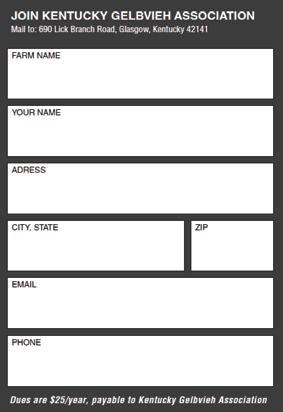
Saturday, January 25, 2025 • Nelson County Extension Office • 317 S. Third Street Bardstown, Kentucky 40004 • 11:30 am eastern time • Lunch will be served prior to


Toby & Debby Dulworth 2492 S. Kirkman Road LaCenter, KY 42056 (270) 224-2993 • dogwood@brtc.net Herefords that thrive on forages. www.dogwoodherefords.com

Codee Guffey • 1815 Grassy Springs Road Versailles, Kentucky 40383 (502) 598-6355 rockridgeherefords@gmail.com www.rockridgeherefords.com
Tony & Kathy Staples 992 Knotts Road Brandenburg, KY 40108 (270) 945-9277 (270) 422-4220 tstaples@bbtel.com
Registered Polled Herefords
HANSELL PILE, JR.
12045 St. John Rd. Cecilia, KY 42724 270-735-5192
12 miles West of Elizabethtown

Shannon, Kerry, Emily, Will & Ellie Morgan 13095 Scottsville Rd, Alvaton, Kentucky 42122
www.morganandmorganpolledherefords.com
Shannon: (270) 320-2389
Kentucky Beef Expo National Hereford Show & Sale and Junior Show February 28- March 2, 2025
Kentucky Beef Expo Schedule
Friday March 1st - Hereford Show - 1pm

Saturday March 2nd - Hereford Sale - 1pm
Sunday March 3rd - Open Junior Show - 8am
WELLS FARM
FARM
Polled Herefords 439 Flatwoods Frozen Camp Rd, Corbin KY 40701
Bobby & Brenda Wells (606) 344-0417 wells_farm@yahoo.com
KHA OFFICERS
Polled Herefords 439 Flatwoods Frozen Camp Rd, Corbin KY 40701
NJB Limited
Toby & Debby Dulworth 2492 S. Kirkman Road LaCenter, KY 42056 (270) 224-2993 dogwood@brtc.net
Bobby & Brenda Wells (606) 523-0569 or (606) 344-0417 wells_farm@yahoo.com
Kevin, Angela, Kenlea & Kyler Murray (606) 528-1691 or (606) 682-8413
Herefords that thrive on forages. www.dogwoodherefords.com

6077 Helena Road
6077 Helena Road
Mayslick, KY 41055
Dale Stith 5239 Old Sardis Pike Mays Lick, KY 41055 dalestith@yahoo.com (918) 760-1550
Kevin, Angela, Kenlea & Kyler Murray (606) 528-1691 or (606) 682-8413

President: Chris Hopper 606-584-7842
LW Beckley DVM • 859-779-1419
Secretary/ Treasurer: Melinda Watson 859-625-8660 melindawatson8660@gmail.com
Dale Stith 5239 Old Sardis Pike Mays Lick, KY 41055 dalestith@yahoo.com (918) 760-1550
Secretary/ Treasurer Melinda Watson • 859-625-8660 melindawatson8660@gmail.com
Codee
Versailles, rockridgeherefords@gmail.com www.rockridgeherefords.com
K3 CATTLE REGISTERED HEREFORDS KYLE BUSH
K3 CATTLE REGISTERED HEREFORDS
KYLE BUSH

Mayslick, KY 41055
Charlie Boyd II 606-584-5194
Charlie Boyd II 606-584-5194
Annual Bull Sale second Saturday in March Hereford and Angus Bulls
Annual Bull Sale second Saturday in March Hereford and Angus Bulls
Registered Polled Herefords
PAUL L. HANCOCK 8559 KY 56 Owensboro, KY 42301 270-771-4194
Registered Polled Herefords PAUL L. HANCOCK 8559 KY 56 Owensboro, KY 42301 270-771-4194
K3CATTLE@YAHOO.COM 859-588-4531
198 HICKS PIKE CYNTHIANA, KY 41031
K3CATTLE@YAHOO.COM 859-588-4531 198 HICKS PIKE CYNTHIANA, KY 41031
Polled Hereford and Gelbvieh Cattle 3459 KY Hwy. 1284 E. Cythiana, KY 41031 (859) 234-6956
Polled Hereford and Gelbvieh Cattle
3459 KY Hwy. 1284 E. Cythiana, KY 41031 (859) 234-6956
Ben, Jane, Shelby and Lincoln
Ben, Jane, Shelby and Lincoln
Tony 992 Brandenburg, tstaples@bbtel.com
Hereford Farms
Hereford Farms
Brad, Carla, Clay & Clint Chambliss 1101 Driftwood Lane

Brad, Carla, Clay & Clint Chambliss 1101 Driftwood Lane Elizabethtown, KY 42701
Elizabethtown, KY 42701
Home (270) 982-3905
Home (270) 982-3905
Cell (270) 668-7126 fax 270-735-9922
www.chamblissherefordfarms.com
Cell (270) 668-7126 fax 270-735-9922 www.chamblissherefordfarms.com
Registered Polled Herefords Bulls & Females for sale
WCN Polled Herefords
Since 1961
Tim & Peggy Wolf 12939 Peach Grove Road Alexandria, KY 41001
Bill Norris 2220 Celina Road
Burkesville, KY 42717
Home: 859-635-0899 Cell: 859-991-3484
Phone (270) 433-7256
Cell (270) 433-1525
“Every calf needs a white face”

Peyton’s Well Polled Herefords The Lowell Atwood Family 133 Edgewood Drive • Stanford, KY (606) 365-2520 home/fax (606) 669-1455 cell
Victor- influenced cattle bred for performance on grass. “Black cows need a good Hereford Bull”
Jackson Farms
Jackson Farms
Registered Polled Herefords PO Box 215 Cross Plains, TN 37049 615-478-4483
Registered Polled Herefords PO Box 215 Cross Plains, TN 37049 615-478-4483
billymjackson@aol.com
billymjackson@aol.com
“Farming the Same Land Since 1834”
“Farming the Same Land Since 1834”

Registered Polled Herefords Bulls & Females for sale
Tim & Peggy Wolf 12939 Peach Grove Road
L. Wayne Beckley • 1420 Fitchburg Rd. Ravenna, KY 40472 • 606-723-3021 Cell: 859-779-0962
Alexandria, KY 41001
Home: 859-635-0899
Cell: 859-991-3484
L.W. Beckley D.V.M 284 Pyrse Lane • Irvine, KY 40336 Cell: 859-779-1419 • Clinic: 606-726-0000 www.beckleyherefords.com

Danny Miller jmspolledherefords.com
270-465-6984
270-566-2694
Eric & Ronnie Thomas 2396 Union City Rd. Richmond, KY 40475 (859) 623-5734
Eric & Ronnie Thomas 2396 Union City Rd. Richmond, KY 40475 (859) 623-5734
Eric’s Cell (859) 314-8256
Eric’s Cell (859) 314-8256
“Cattle for sale at all times”
“Cattle for sale at all times”

BECKLEY HEREFORDS
Jackie D. Perkins II 367 Mt. Pisgah Rd. Bremen, KY 42325 (270) 543-3586
Jackie D. Perkins II 367 Mt. Pisgah Rd. Bremen, KY 42325 (270) 543-3586
Breeding to produce good cows since 1981
Breeding to produce good cows since 1981

Registered HANSELL 12045 Cecilia, 12 miles
Tucker Stock Farms
L. Wayne Beckley • 1420 Fitchburg Rd. Ravenna, KY 40472 • 606-723-3021
Cell: 859-779-0962
L.W. Beckley D.V.M 284 Pyrse Lane • Irvine, KY 40336
Cell: 859-779-1419 • Clinic: 606-726-0000
www.beckleyherefords.com
“Breeding Polled Herefords for over 58 Years” Breeding cattle for sale at all times. 1999 Walnut Hill Rd. Lexington, KY 40515 (859) 271-9086 cell (859)533-3790

WATSON LAND & CATTLE
Matt, Melinda, Harlee, & Wyatt Watson 6196 Mount Sterling Rd Flemingsburg, Kentucky melindawatson8660@gmail.com - 606-748-1600 Melinda - 859-625-8660
CATTLE
“Registered Angus and Polled Herefords”
“Breeding Polled Herefords for over 58 Years” Breeding cattle for sale at all times.
John Tucker II 1790 Hidden Valley Lane Hudson, KY 40145 270-617-0301
1999 Walnut Hill Rd. Lexington, KY 40515 (859) 271-9086 cell (859)533-3790 Tucker and
“Bulls always for Sale”

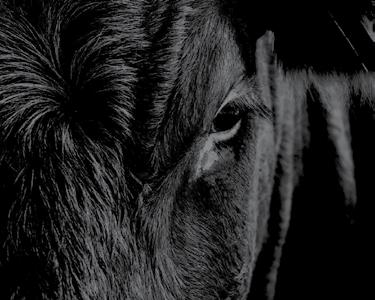
FOUR WINDS FARM N ew Castle, Kentucky (502) 296-1044
PERFORMANCE TESTED PUREBRED ANGUS
BULLS FOR SALE Call 270-202-7186 for more info or check out www.oakhollowangus.com for current availability.
POLLED HERFORD BULLS FOR SALE
19–20-month-old Polled Hereford bulls. Good selection. Low birthweight, medium frame. Free Delivery Available.
JMS Polled Herefords, Knifley, KY Danny 270-566-2694 Trent 270-566-2000
RED FULLBLOOD LIMOUSIN
BLACK PUREBRED LIMOUSIN For sale year-round at farms Cows, bulls, heifers and semen
A C H Holdings, Bowling Green, KY Stephen Haynes 270-799-8685
REGISTERED BLACK SIMMENTAL BULLS
Many blaze faced. Excellent EPD’s. Semen Tested. Delivery Available. Maximize your profit with proven performance. All bulls qualify for new CAIP cost-share. Adam Wheatley 502349-2665
BREEDING AGE HEREFORD BULLS FOR SALE AT ALL TIMES
Over 60 years of Line 1 Hereford Genetics. Groups of open and bred heifers available for sale at all times.
Chambliss Hereford Farms. 270-668-7126
HOOVER NO DOUBT REGISTERED ANGUS
YEARLING BULLS 12 available. Excellent EPDs. Docile, Genomic Tested. Contact Triple P Angus, 606-724-5524 or 606-407-2355
Red Hill Farms, Lafayette, TN, 615-666-3098
Bart, Sarah and Ty Jones
Gordon and Susan Jones, 270-991-2663
Visit us online - www.RedHillFarms.net
Contact us for cattle and semen availability. Annual Production Sales:
More Than a Bull Sale – 3rd Saturday in March
Maternal Monday – 3rd Monday in May
Bulls & Females of Fall Sale – Last Saturday in October
Farmco feeders wagons
TMR mixers- parts in stock
Tubs- rims/ tires- knives- planetary fluids
S B 200 Artex manure spreader- $39,000 Meyer and Cloverdale TMR mixers in stock
Zero down $$$$ for 11 months Kubota 90 skid loader Esch 12 ft drill
$47,500 Meyer 4618- super clean $26,500 NH 100 TL- cab loader- 2wd-$28,000 JD 567- string -$19,995 New Holland BR 7060-string - $11,995 Farmco feeders- in stock JD 5420- 4wd canopy- loader $26,500 JD 6715- 2wd canopy- 16 PS- $$$$
Call Charlie for a hot deal today!!!! 859-608-9745
2 years in February. Semen checked, birth weights and EPDS. Calving Ease & Growth, BQA. Metropolis, IL, 618-638-7693, www.bremerbrothers.com

Katie VanValin University of Kentucky, Assistant Extension Professor
When used correctly, growthpromoting technologies are valuable tools that improve efficiency and increase weight gain in growing cattle. In the cow-calf sector, these include ionophores and implants. Although “technology” often implies something new, these tools have been staples of the beef industry for decades. Yet, their adoption seems stagnant or even declining. Why?
Ionophores
Ionophores are antimicrobial feed additives, including monensin (Rumensin®), lasalocid (Bovatec®), and laidlomycin propionate (CATTLYST®). While ionophores are antibiotic-like, they are not classified as medically important for humans and do not require a veterinary feed directive (VFD). This means they can be purchased without a prescription but must be bought premixed from a feed dealer, as they are considered a medication.
The rumen hosts a multitude of microorganisms that digest feed and produce volatile fatty acids (VFAs), which the animal uses for energy. Acetate is the most common VFA, but propionate is more energetically efficient. Feeding ionophores shifts VFA production toward propionate, leading to increased average daily gains, improved feed efficiency and even reduced methane production. Ionophores also help prevent bloat, acidosis and coccidiosis. With the multitude of benefits, it is no surprise that approximately 90% of cattle on feed in the United States consume ionophores. While ionophores are typically used for growing cattle, they can also benefit replacement heifers and cows by decreasing the age of puberty and shortening the postpartum interval, thereby improving reproductive performance. Ionophores can be mixed into feed, and some pre-mixed products like free-choice minerals and tubs are
available. Always read and follow label directions. Some products containing ionophores may be labeled for specific classes of animals, and there is potential for toxicity to occur when fed improperly. Horses are particularly sensitive to ionophores, so avoid accidental feeding of ionophore-containing feeds to horses.
Implants are small pellets containing hormones inserted into the back of the ear. Over time, the implant is absorbed, increasing the secretion of growth hormone, promoting protein synthesis and reducing protein degradation. Simply put, implants increase average daily gain. Implants have been used for decades and are arguably one of the most consistent practices in agriculture. Suckling calves implanted at around 90 days old often have weaning weights 10–20 lbs. higher than non-implanted calves.
However, a recent survey of Kentucky beef producers revealed that only 21% implant their calves, meaning 79% of respondents were leaving potential revenue untapped. My rule of thumb is that unless calves are marketed to receive a premium covering the money left on the table by not implanting (i.e. natural programs), calves should be implanted. Implanting is quick, taking less than one minute per calf. With calves priced at $2.70/lb., an additional 20 lbs. from implanting means a 500-lb. calf worth $1,350 becomes a 520lb. calf worth $1,404. The cost of calfhood implants is less than $2 per head. For a 30-head herd, an extra half hour of work yields an additional $1,600, or more than one extra calf!
It’s a common misconception that delayed castration of bull calves will bring greater revenue due to increased growth rates, while in reality these calves may weigh more
but will be subject to discounts at the sale barn. Implanting suckling steer calves can lead to growth similar to that of intact bull calves, allowing for early castration without losing growth potential and avoiding discounts for selling bulls. Research shows that early castration is less stressful than castration at or after weaning. Thus, implants are an effective strategy to capture growth while reducing animal stress. This is why many of the chute-side Beef Quality and Care Assurance (BQCA) trainings that have been hosted in partnership between the Kentucky Beef Network and the University of Kentucky Beef Extension Team have focused on demonstrating safe and effective methods of early castration as well as implanting. These two practices are a winning combination for Kentucky’s cow-calf producers.
For heifers, timing is critical. Research suggests that implants can negatively impact fertility depending on when they are administered. The general recommendation is to avoid implanting replacement heifers. However, heifers marketed as feeders can certainly benefit from implants. Be mindful of the implant's payout period—the time it remains effective. To maximize benefits, administer implants far enough in advance to capture the full payout period. For example, if an implant has a payout period of 100 days, it should be administered at least 100 days before marketing the cattle.
If ionophores and implants are not part of your management strategy, consider how they could benefit your operation. Regardless of market conditions, these technologies are safe, proven and effective tools to increase revenue in the cowcalf sector. For questions about ionophores or implants, contact your local extension office.
Spring-Calving Cow Herd
• Study the performance of last year's calf crop and plan for improvement. Plan your breeding program and consider a better herd sire(s). Select herd sires which will allow you to meet your goals and be willing to pay for superior animals.
• Consider vaccinating the cows to help prevent calf scours.
• Keep replacement heifers gaining to increase the probability of puberty occurring before the start of the spring breeding season.
• Start cows on the high magnesium mineral supplement soon. Consider protein supplementation if hay is less than 10% crude protein. If cows are thin, begin energy (grain) supplementation now. Cows must reach a body condition score of 5 before calving to maximize their opportunity for reproductive success. Supplementation now allows adequate time for cows to calve in adequate body condition score.
• Get ready for the calving season! See that all equipment and materials are ready, including obstetrical equipment, record forms or booklets, ear tags, scales for obtaining birthweights, etc. Prepare a calving area where assistance can be provided easily if needed. Purchase ear tags for calves and number them ahead of time, if possible. Plan for enough labor to watch/assist during the calving period.
• Move early calving heifers and cows to pastures that are relatively small and easily accessible to facilities in case calving assistance is needed. Keep them in good condition but don't overfeed them at this time. Increase their nutrient intake after they calve.
Fall-Calving Herd
• Provide clean windbreaks and shelter for young calves.
• Breeding season continues. Keep fall-calving cows on accumulated pasture as long as possible, then start feeding hay/grain/supplement. Don’t let these cows lose body condition!
• Catch up on castrating, dehorning and implanting.
General
• Feed hay in areas where mud is less of a problem. Consider preparing a feeding area with gravel over geotextile fabric or maybe a concrete feeding pad. Bale grazing is an option for producers to help control mud while spreading nutrients across pastures.
• Increase feed as the temperature drops, especially when the weather is extremely cold and damp. When temperature drops to 15°F, cattle need access to windbreaks.
• Provide water at all times. Cattle need 5 to 11 gallons per head daily even in the coldest weather. Be aware of frozen pond hazards. Keep ice "broken" so that cattle won't walk out on the pond trying to get water. Automatic waterers, even the “frost-free” or “energyfree” waterers can freeze up in extremely cold weather. Watch closely.
• Consider renovating and improving pastures with legumes, especially if they have poor stands of grass or if they contain high levels of the fescue endophyte. Purchase seed and get equipment ready this month.
Friday, March 7, 2025 • 6:30 P.M. CDT
Russell County Stockyard
Russell Springs, KY

Smithland Angus Farm 4437 East Highway 80 Russell Springs, Kentucky 42642 Henry Bryan, Melissa, Bryanna and Blane Smith 606-271-7520 bmsmith@duo-county.com Since 1940

SATURDAY • MARCH 22, 2025 • 1:00 EST

• Son of the ST Genetics sire, Poss Winchester. Dam maintains a calving interval of 5/368 with progeny ratios of WW 4/109, YW 4/112, IMF 4/124, RE 4/100.
• Moderate BW with explosive growth: top 4% WW, 2% YW. 3569 checked all the performance boxes with ratios of WW 124, YW 127, IMF 144, RE 102, ADG 128.
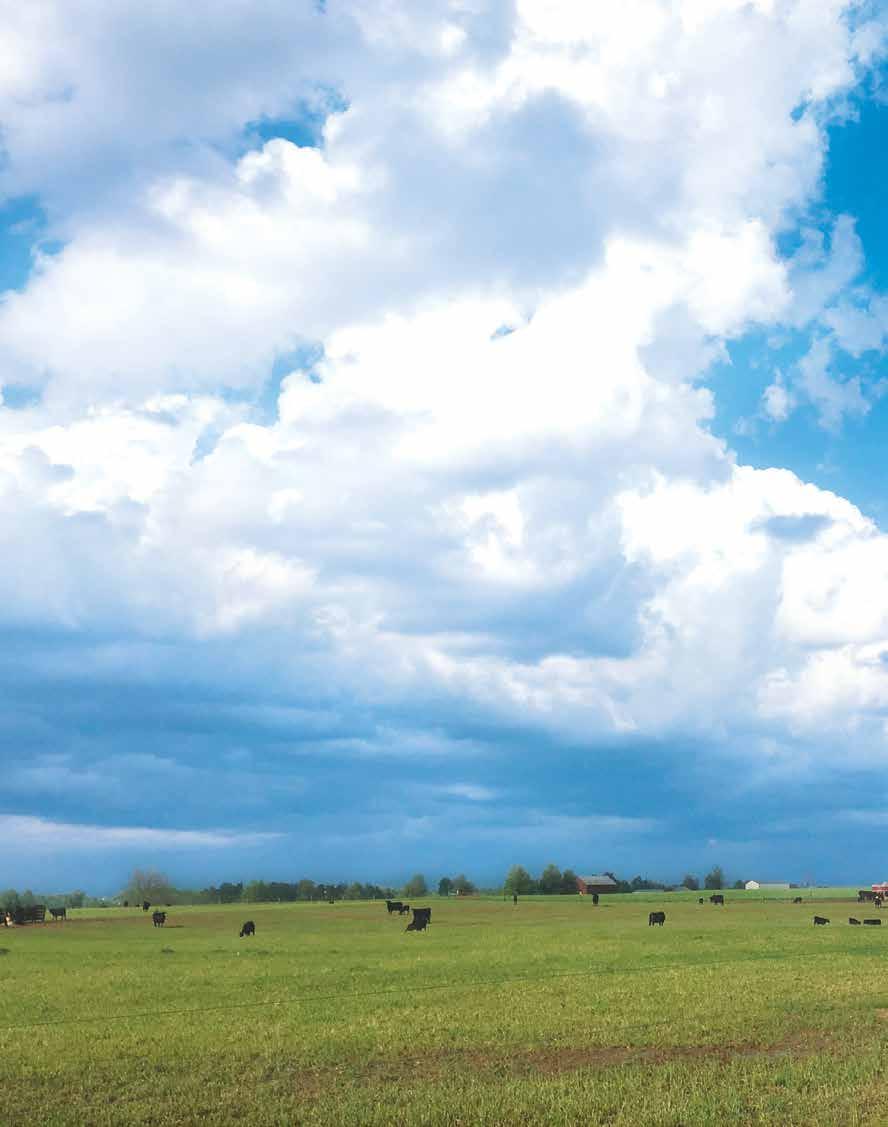

• Son of the ST Genetics sire, KCF Bennett Exponential.
• Double digit CE with top 10% WW and 15% YW.
• Pathfinder dam maintains a calving interval of 6/372 with progeny ratios of WW 5/109, YW 5/103, IMF 13/103, RE 13/102.
• Sleep all night calving ease with top 15% WW, 20% YW. BV
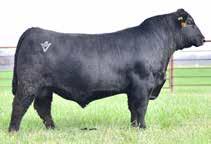
• Son of the ST Genetics sire, Connealy Commerce. Dam maintains a calving interval of 3/366 with progeny ratios of WW 2/119, YW 2/113, RE 2/111.
2 20

• Son of the ST Genetics sire, Connealy Craftsman.
• Moderate BW with top of breed growth: top 1% WW and 2% YW. Solid set of indexes: 2% $W, 15% $C, 20% $B, $G, 30% $F.
• 1595 posted an 898 WW with a dominate set of performance ratios: WW 131, YW 124, IMF 113, RE 104.